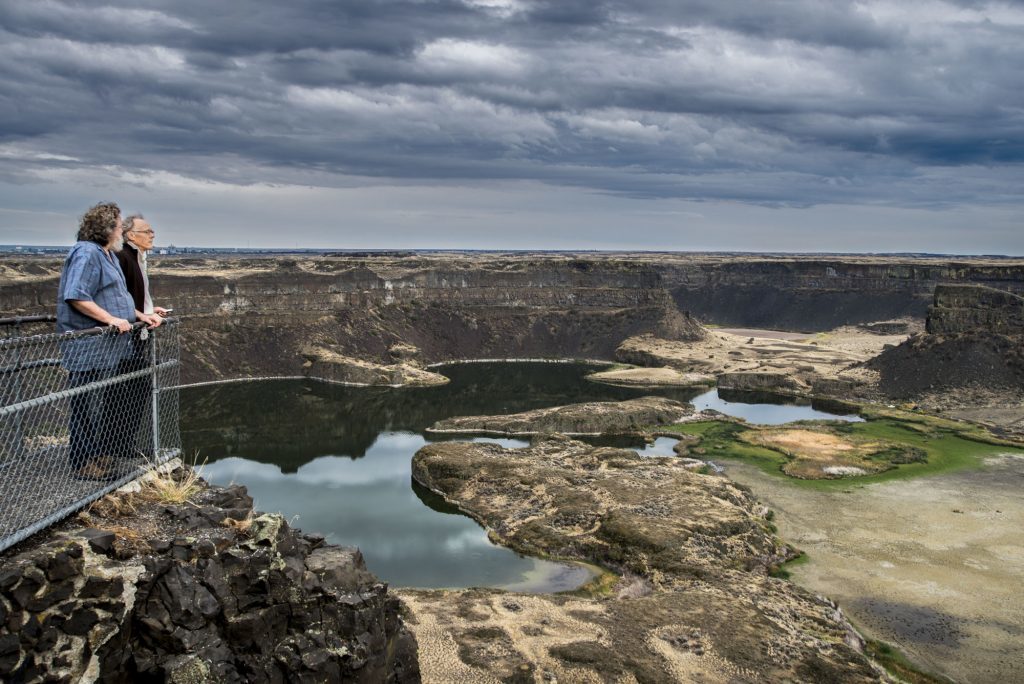
There is fierce disagreement amongst mainstream scientists - a disagreement that also divides alternative researchers - around what happened to the Earth, and to humanity, in the closing millennia of the last Ice Age between 12,800 and 11,600 years ago. Marked by intense cold, global floods and extinctions of animal species, this 1200-year interval is known to geologists as the Younger Dryas. Many of the leading investigators are convinced the agent of the mysterious earth changes, and of the extinctions, was a comet that the struck the North American ice cap with globally cataclysmic effects. But their "Younger Dryas Impact Hypothesis" is still regarded as controversial by others who have sought, more than once in the scientific literature, to declare it "disproved" only to be confronted by compelling new evidence that further strengthens the case. In this article, Graham Hancock shows how scientists consistently suppress and marginalise new knowledge that conflicts with established positions and argues that a paradigm shift is underway - a shift that will require us to reconsider everything we've been taught about the peopling of the Americas and about the very origins of civilization.In March 2017 the National Geographic Society and the Smithsonian Institution, those bastions of scientific orthodoxy, highlighted the remarkable achievements of two scientific rebels, one retired and the other deceased, confessing that multiple injustices had been done to both and that the "toxic" way in which they had been treated by their professional colleagues had "poisoned" scientific progress.
In the case of The Smithsonian the focus was on Canadian archaeologist Jacques Cinq-Mars, ostracised in the 1990's because his excavations at Bluefish Caves in the Yukon "directly challenged mainstream thinking" with evidence that the peopling of the Americas had begun many thousands of years earlier than had previously been thought.1
We will have more to say about the case of Dr Cinq-Mars in the second half of this article.
Meanwhile for National Geographic the rebel of choice in 2017 was US geologist J. Harlen Bretz, condemned to pariah status in the 1920's for daring to propose that a gigantic flood had scoured the "scabland" of America's Pacific Northwest near the end of the last Ice Age.2 It was an idea that contradicted the consensus view of scientists at the time that geological transitions were always slow and gradual - a view in which there was no place for sudden and cataclysmic earth changes.
Bretz died in 1981, soon after Cinq-Mars began his paradigm-busting excavations in the Yukon. The two men did not know one another and worked in entirely different fields. What they have in common, however, and the reason that the mainstream science press which once attacked them now sings their praises, is that both spent decades being vilified by their scientific peers but were ultimately proved right.
Here is Bretz, writing in 1928 after one of his field trips across Washington State in the Pacific Northwest of the US:
"No one with an eye for landforms can cross eastern Washington in daylight without encountering and being impressed by the '"scabland'." Like great scars marring the otherwise fair face of the plateau are these elongated tracts of bare, or nearly bare, black rock carved into mazes of buttes and canyons. Everybody on the plateau knows scabland. It interrupts the wheat lands, parcelling them out into hill tracts less than 40 acres to more than 40 square miles in extent. One can neither reach them nor depart from them without crossing some part of the ramifying scabland. Aside from affording a scanty pasturage, scabland is almost without value. The popular name is an expressive metaphor. The scablands are wounds only partially healed - great wounds in the epidermis of soil with which Nature protects the underlying rock.By 1928 Bretz was an experienced and highly credentialed field geologist. Born in 1882, he'd started his career as a high school biology teacher in Seattle but spent most of his spare time exploring the geology of Puget Sound. Although he didn't have a geology degree at the time, he succeeded in getting several articles on his findings published in scientific journals.4 In 1911 he enrolled at the University of Chicago to pursue a doctorate in geology. He graduated summa cum laude in 1913 and immediately thereafter returned to Seattle where he accepted a position as assistant professor of geology at the University of Washington.5 He had difficulties with the attitudes of other teaching staff there (he later described them as "stick-in-the-muds"6) and by 1914 he was back at the University of Chicago, initially as an instructor but soon afterward as an assistant professor.7
"With eyes only a few feet above the ground the observer today must travel back and forth repeatedly and must record his observations mentally, photographically, by sketch and by map before he can form anything approaching a complete picture. Yet long before the paper bearing these words has yellowed, the average observer, looking down from the air as he crosses the region, will see almost at a glance the picture here drawn by piecing together the ground-level observations of months of work. The region is unique: let the observer take the wings of the morning to the uttermost parts of the earth: he will nowhere find its likeness."3
The first field trip Bretz made to the scabland of eastern Washington was in 1922. By this point, as a result of his earlier work, he was fully informed about the Ice Age in all its dimensions and more aware than most other geologists that immense ice sheets up to two miles deep, had covered North America for the best part of 100,000 years until the ice melted dramatically somewhere between 15,000 and 11,000 years ago. Thus when he saw huge numbers of erratics - giant boulders that didn't belong naturally in the area but had clearly been brought in from elsewhere - he was inclined to assume that they might have travelled here in icebergs carried on some great glacial flood. This impression was strengthened when he explored Grand Coulee and Moses Coulee - gigantic channels gouged deeply in the earth - and visited the Quincy Basin at the southern end of Grand Coulee where he found the whole 600-square-mile depression filled up to a depth of 400 feet with small particles of basalt debris. He couldn't help but wonder, "where had all the debris come from, and when?"8 Again the answer that presented itself to him was a flood.
Bretz was back in the Scablands in 1923 for three months of exploration and it seems to have been during this field trip that his later views - namely that "some spectacular hydrological event . . . had begun in this region, then abruptly stopped", really began to take shape.9
In the November-December 1923 issue of the Journal of Geology Bretz published a paper summarizing his findings. To understand the somewhat defensive tone of the paper it is necessary to keep in mind the prevailing geological doctrine of the time, the principle known as "uniformitarianism". This is the assumption that existing processes, acting as at present, are sufficient to account for all geological changes. Integral to it is the parallel assumption of gradualism, namely that "the present is the key to the past" and that the rate of change observable today is an accurate guide to rates of change that prevailed in the past.
Such ideas, which had acquired the status of unchallengeable truth by the 1920's, had themselves arisen from the needful - indeed essential - overthrow of the old religious belief in creationism and the notion that God whimsically intervened in the earth's history by ordaining cataclysms such as the Biblical Flood. In righteous opposition to these thoughts of supernatural creation and destruction, uniformitarianism seemed a profoundly rational response that saw only the forces of nature at work upon the earth over periods of millions, or indeed billions of years.
'Mountains had not been built overnight, but had risen slowly, imperceptibly over time. Likewise had fantastic geological features such as the Grand Canyon been eroded by the flow of rivers over many millions of years.'10Bretz was an eminently rational man, and certainly no religious dogmatist, yet, as his biographer John Soennichsen notes, "while hiking through the hot, dry, ragged world of the Scablands, everything he had seen pointed not to a slow, uniform change over time but to a catastrophe, a sudden release of colossal quantities of water that had quickly washed away the loessial topsoil and then carved deeply into the basalt rock beneath."11
The problem was - where had all this water come from? It was well understood that at the margin of the North American ice sheets there must have been some melting - as one indeed sees at the edges of all glaciers today. But such melting could hardly explain the magnitude of the erosive changes that were visible in the field. As Bretz noted in his 1923 paper:
"The writer confesses that during ten weeks of study of the region, each newly examined scabland tract reawakened a feeling of amazement that such huge streams could take origin from such small marginal tracts of an ice sheet, or that such an enormous amount of erosion, despite high gradients, could have resulted in the very brief times these streams existed. Not River Warren, nor the Chicago outlet, not the Mowhawk channel, nor even Niagara Falls and Gorge itself approach the proportions of some of these scabland tracts and their canyons. From one of these canyons alone [Upper Grand Coulee] 10 cubic miles of basalt was eroded by its glacial stream."12Concluding the paper, and moving towards the profoundly heretical and anti-uniformitarian idea that would soon get him into a great deal of trouble, namely that a single cataclysmic flood sustained only for a very short period had been responsible for all the devastation he had witnessed, Bretz wrote:
"Fully 3,000 square miles of the Columbia plateau were swept by the glacial flood, and the loess and silt cover removed. More than 2,000 square miles of this area were left as bare, eroded, rock-cut channel floors, now the scablands, and nearly 1,000 square miles carry gravel deposits derived from the eroded basalt. It was a debacle which swept the Columbia Plateau."13In other words, as Bretz's biographer summarizes, the geologist now believed that the features he had documented "could only have been created by a flood of unimaginable proportions, possibly the largest flood in the history of the world".14
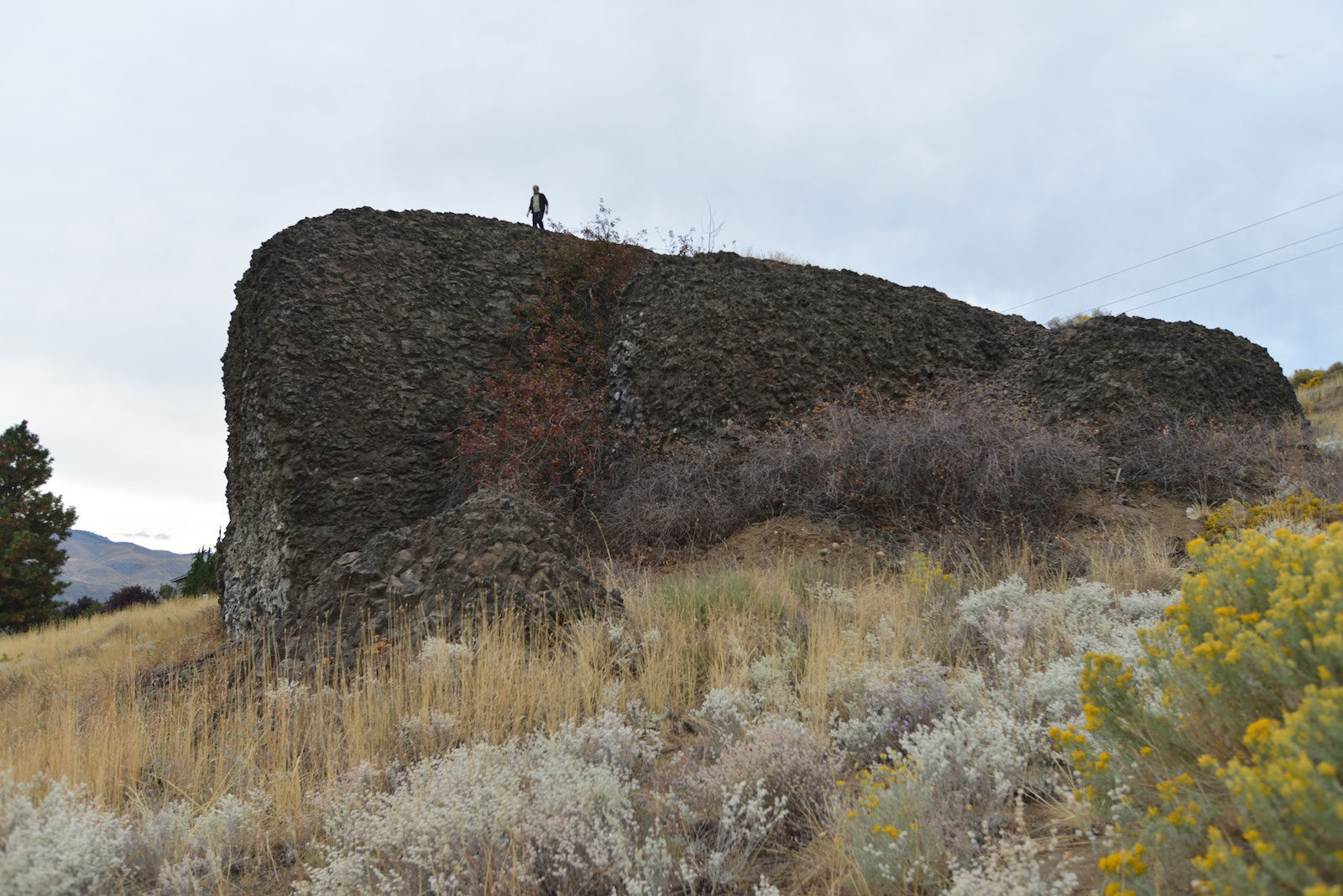
The reaction of the geological establishment was one of stunned, embarrassed silence. To have strayed so far from the doctrine of uniformitarianism could only mean that Bretz must have gone mad. David Alt, Professor Emeritus of Geology at the University of Montana, describes one of the lectures that Bretz gave in which he expounded on the ideas in his 1923 paper:
"The geologists . . . were aghast in the same way that a roomful of physicists would be upon hearing a colleague explain how he had made a perpetual motion machine out of old popsicle sticks. Physicists had all learned very early of the futility of perpetual motion machines, and no properly educated geologist was supposed to traffic in catastrophes of any sort."15Alt describes an old professor of his own undergraduate days who had been a student sitting in the audience when Bretz read his 1923 paper. It seems the professor did a hilarious impersonation of Bretz "pounding on the podium with both fists and stomping on the floor as he used vivid language and gestures to convey his idea of a catastrophic flood to his horrified audience."16
Quite apart from the theatricals, the geologists were shocked to hear Bretz invoke:
"a sudden catastrophe to explain the Scablands of eastern Washington. In their view this was a reversion to the unscientific thinking of some 125 years before. To this day, most geologists consider it nothing less than heresy to invoke a catastrophic explanation for a geologic event. So Bretz stepped off the edge of a very long limb when he suggested that a great flood had eroded the Scablands . . . . [It made] him a pariah among geologists, an outcast from the politer precincts of society."17The outcast did not give up, however. On the contrary, he doggedly continued with his research, bringing down ever more controversy on his own head in the process but believing that the facts, ultimately, would vindicate him.
The crunch came on 12 January 1927 when Bretz was ambushed by a lynch mob of his colleagues at a lecture he'd been invited to give to the Geological Society of Washington in the Cosmos Club, Washington DC. Bretz was by now calling "his" flood the "Spokane Flood" (after the town of Spokane) and liked to refer to the ice sheet from which it had emerged as the "Spokane ice sheet" (neither term is used today but Bretz's Spokane ice sheet was, effectively the southern part of that great late Pleistocene ice sheet now known as the "Cordilleran"). He believed that large parts of it must have melted with extraordinary rapidity, because "the volume of water was very great, almost incredibly great . . .... In spite of high gradients to draw it off, the pre-existing valleys first entered were inadequate to carry it all, and the flood spread widely in a complicated group of anastomosing routes."18
W.C. Alden, then the Chief of Pleistocene Geology with the profoundly conservative US Geological Survey, objected to "the idea that all the channels must have been developed simultaneously in a very short time" and took great offence at "the tremendous amount of water" postulated by Bretz.19 "It seems to me impossible," Alden protested, "that such part of the great ice fields as would have drained across the Columbia Plateau could, under any conditions, have yielded so much water as is called for in so short a time."20 He admitted that he had never visited the scablands himself but felt sure that a uniformitarian explanation was what was required. "The problem would be easier," he opined, "if longer time and repeated floods could be allotted to do the work."21
James Gilluly, well known as an apostle of geologic gradualism, dismissed the notion of a single cataclysmic flood with words like "preposterous", "incompetent", and "wholly inadequate".22 He found nothing in Bretz's evidence to exclude his own preferred solution, namely that multiple smaller floods had been involved and that these would have been "of the order of magnitude of the present Columbia's, or at most a few times as large".23
Likewise G.R. Mansfield doubted that "so much work could be done on basalt in so short a time . . . The Scablands seem to me better explained as the effects of persistent ponding and overflow of marginal glacial waters, which changed their position or their places of outlet from time to time through a somewhat protracted period."24
O.E. Meinzer was obliged to confess that "the erosion features of the region are large and bizarre" but he, too, preferred a gradualist explanation: "Before a theory that requires a seemingly impossible quantity of water is fully accepted, every effort should be made to account for the existing features without employing so violent an assumption . . . I believe the existing features can be explained by assuming normal stream work of the ancient Columbia River . . ."25
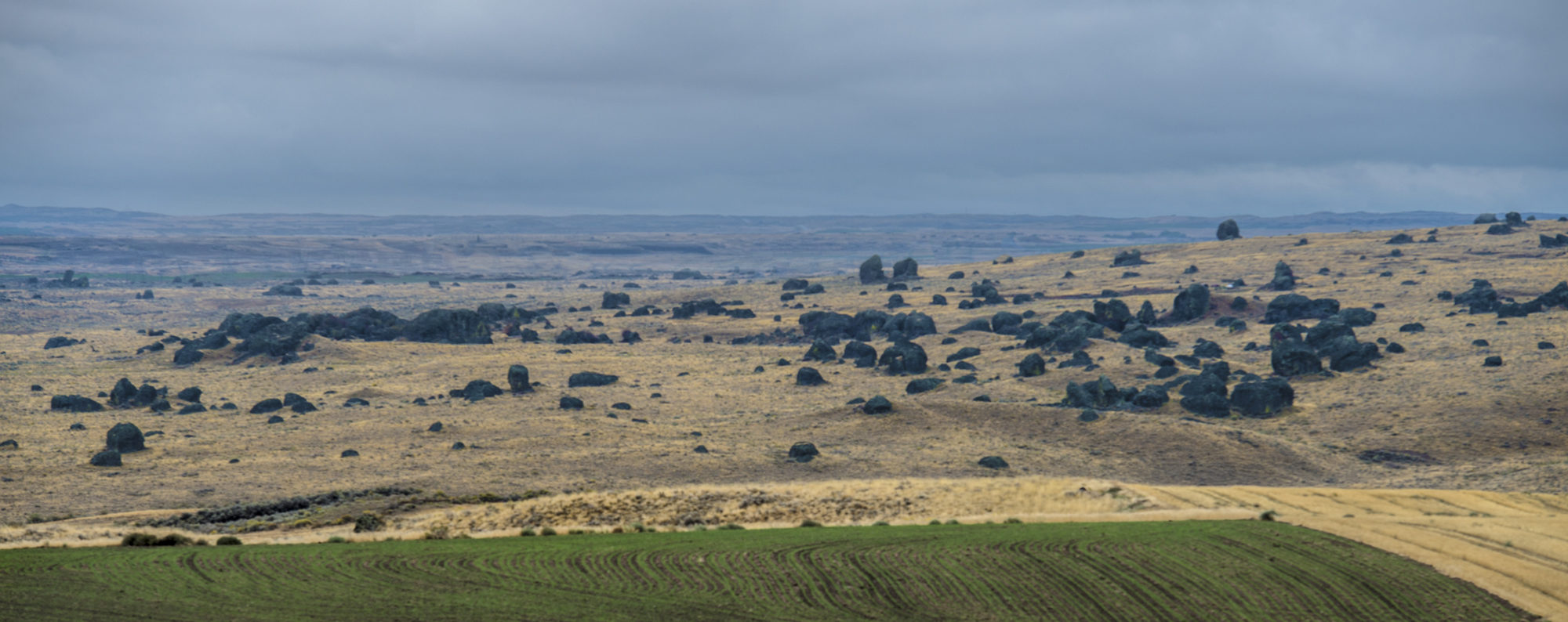
Bretz replied that he saw no logic in this, since lack of a documented source for the flood did not prove that there had been no flood. "I believe that my interpretation of channeled scabland should stand or fail on the scabland phenomena themselves," he argued.26 He was, he said, as sensitive as anyone else to adverse criticism, and had "no desire to invite attention simply by advocating extremely novel views." Moreover, he himself had repeatedly been driven to doubt "the verity of the Spokane Flood",27only to be forced "by reconsideration of the field evidence, to use again the conception of enormous volume . . . These remarkable records of running water on the Columbia Plateau, and in the valleys of the Snake and Columbia Rivers, cannot be interpreted in terms of ordinary river action and ordinary valley development . . . Enormous volume, existing for a very short time, alone will account for their existence."28
It was this accumulation of compelling field evidence that Bretz asked to be considered - not by emotion, not by intuition, not by reference to received wisdom, but only by "the established principles of the scientific method".29 "Ideas without precedent," he was to write later:
"are generally looked on with disfavor and men are shocked if their conceptions of an orderly world are challenged. A hypothesis earnestly defended begets emotional reaction which may cloud the protagonist's view, but if such hypotheses outrage prevailing modes of thought the view of antagonists may also become fogged.
"On the other hand, geology is plagued with extravagant ideas which spring from faulty observation and misinterpretation. They are worse than 'outrageous hypotheses', for they lead nowhere. The writer's Spokane Flood hypothesis may belong to the latter class, but it cannot be placed there unless errors of observation and direct inference are demonstrated."30
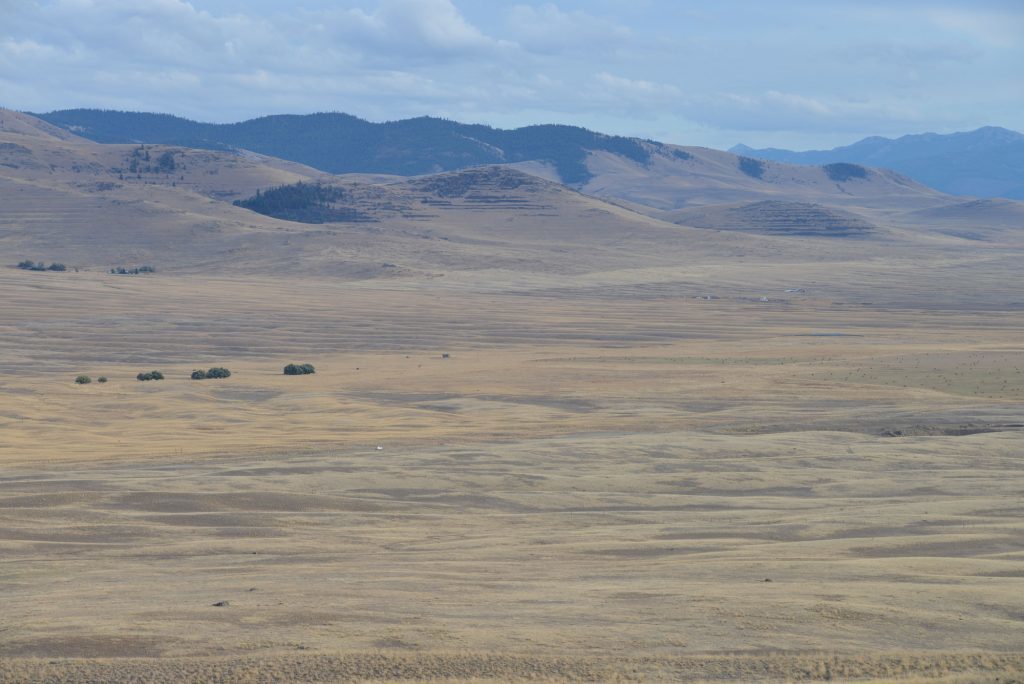
The heart of the matter remained Bretz's assertion that the ice cap had melted precipitously and his inability to propose a mechanism that could have brought about such melting. He himself, as noted, did not regard this as a significant stumbling block, but his critics did. Over the years, therefore, in attempts to appease them, he several times reluctantly, proposed two possible solutions. These were some sort of radical, short-lived climate change, on the one hand or, on the other, an episode of volcanic activity beneath the ice cap. He admitted of the former, however, that "no such climatic change is recorded elsewhere, and the rapidity demanded seems impossible", while of the latter, he observed that "nothing has been found in the literature to suggest Pleistocene volcanism in the area which was drained across the Columbia Plateau."32
Interestingly, by the time Bretz faced his hostile peers in Washington he was already aware of - but had dismissed - the very explanation for cataclysmic flooding that would much later be taken up by the geological establishment and open the door to the universal acceptance of his evidence that prevails today. In his outline for his January 1927 presentation he wrote: "Both Mr Alden and Mr Pardee have suggested that I consider the sudden draining of a glacial lake to account for the flood . . . Mr Pardee [in a 1925 letter to Bretz] specifies Lake Missoula, which is the only one of any magnitude known in the region that might have functioned."33
Eventually, in the 1940's, Bretz would indeed embrace a sudden draining of Glacial Lake Missoula as the source for his flood but the reason why he did not do so in 1927 is important and, as we shall see, of the greatest relevance to the evolving debate about what exactly happened in North America at the end of the Ice Age. In brief Bretz's view in 1927, as his biographer explains, was that the volume of Lake Missoula would not have been adequate to form the scablands. "Twould run the flood for only 2 weeks," reads a handwritten comment by Bretz in this section of his outline.34
In March 1930, Bretz published a brief abstract in the Bulletin of the Geological Society of America. The abstract was titled "Lake Missoula and the Spokane Flood". In it Bretz wrote that this lake had first been named and described by the geologist J.T. Pardee (whose letter on the subject he'd received in 1925), that it stood more than 4,000 feet above sea level and that it was at least 2,100 feet deep. Without going into any detail he noted that the lake had been held in place by an ice dam and that "seventy miles to the south-west, along the western arm of Purcell Trench and Spokane Valley, are the easternmost heads of the scabland channels. If a bursting of the dam occurred, water could escape only along this seventy-mile stretch."35
By 1932 Bretz had warmed further to the idea that Lake Missoula could be the culprit behind his flood, although he felt that issues concerning the hypothetical ice dam and its proposed cataclysmic failure remained to be worked out.36 At this point in his life, however, he seemed ready to move on and was to devote most of the next decade to other, completely different, geological puzzles. Then, in 1940, he was invited to speak on his scablands theory at a meeting of the American Association for the Advancement of Science being held in Seattle. He declined the invitation, saying that his views and evidence were already on the record, but the event turned out to be a seminal one. J.T. Pardee was there and presented a paper on his work on Glacial Lake Missoula, making public for the first time his long-held conclusion that there had been a failure of an ice dam and that "the entire lake had drained catastrophically and, most likely, quite dramatically".37
Curiously Pardee did not connect his Missoula findings to Bretz's own long-standing and well-known case about the creation of the Channeled Scablands by a catastrophic flood, but much later, Bretz would write: "He never said, at least in print, anything about the final deposition of this vigorous discharge. I do believe, however, that he was generously leaving that to me."38
In the process of making the most of what had been left to him, Bretz abandoned his single cataclysmic flood model in favour of one more palatable to his opponents. "There were several floods," he was eventually to write (in 1959). "The theory is elastic enough to take care of that."39 In the same year, Bretz was presented with the Neil Milner Award in honour of his exceptional contributions to Earth Sciences.'40
A few years later, in 1965, Bretz's transformation from pariah to poster boy seemed complete. The International Union for Quaternary Research organized a field trip to the Columbia Plateau for many former critics of the catastrophic flood theory. The group traversed the full length of Grand Coulee, part of the Quincy Basin, and much of the Palouse-Snake scabland divide. At the end of the trip the participants , humbled by what they had seen, and satisfied as to the source of the flood-damage in Glacial Lake Missoula, sent Bretz a telegram of greetings and salutations. The telegram closed with the words: "We are all now catastrophists."41
"Be assured," wrote Bretz, "that after 30 years, and 30 papers in self-defense, and more than 30 people who vigorously denied my theory, it did my heart good like medicine."42
The final accolade came in 1979 when Bretz, by then aged 96, was awarded the Penrose Medal, the Geological Society of America's highest accolade. After receiving the award, he told his son: "All my enemies are dead, so I have no one to gloat over."43
Gradualism draws the teeth of Bretz's cataclysm
So . . . all seemed well. The evidence of a land scoured by cataclysmic deluge could not be denied. The timing had been set - perhaps not precisely, but at any rate somewhere in the last millennia of the Ice Age between 15,000 and 11,000 years ago. The source of the deluge had been tracked down to Glacial Lake Missoula. And the crunch-point of whether there had been just one gigantic flood - which Bretz's honed instincts as a field geologist had originally suggested - or multiple floods as his gradualist colleagues preferred, had been conceded with reference to the elasticity of his theory and an allowance of "several" floods.
It becomes clear in later papers published by Bretz that he was willing to accept that up to eight floods had occurred.44 This was, undoubtedly, a concession to gradualism - eight smaller floods politely spread out over a period of some thousands of years being more palatable to those of a uniformitarian persuasion (i.e. to most geologists, then and now) than a single humungous event of great violence that occurred suddenly, did massive damage, and was over and done with in about three months. Nonetheless Bretz remained a catastrophist at heart. Victor R. Baker of the Department of Hydrology and Water Resources at the University of Arizona notes in his study, The Spokane Flood Debates, that while Bretz did indeed extensively modify his original hypothesis:
"there was a lingering suspicion that one was dealing with an unusual exception to a general rule. Bretz had himself claimed: 'The unique assemblage of forms . . . described . . . as the channeled scabland . . . records a unique episode in Pleistocene history . . . Special causes seem clearly indicated'."45In other words, regardless of any concessions, what is referred to here are causes that were still unique and special enough to be described as catastrophic and that did not undermine the conclusion that "it was a debacle which swept the Columbia plateau".46 It is surely significant, in his last published work, a note he wrote to the Geological Society of America in 1979 accepting the Penrose Medal, that Bretz took the opportunity to drive this point home. "Perhaps," he wrote:
"I can be credited with reviving and demystifying legendary catastrophism and challenging a too rigorous uniformitarianism."47What Bretz the catastrophist and challenger of uniformitarianism could not have known, however was that once he had invited the vampire of gradualism through the door it would not be satisfied with the compromise that he had tried to strike, but would keep on remorselessly sucking the blood out of any notion that what had happened in the Channeled Scablands had been any sort of "debacle" at all.
Thus, as the years have gone by and new generations of gradualist scholars have taken their places at universities around the world, the eight floods that were first allowed to modify Bretz's single cataclysm have steadily increased in number - to a dozen, then to more than twenty, then to thirty-five, then to "about forty", and finally, in recent papers, to as many as ninety or more!48 "The most current opinion," summarizses Vic Baker, "is that there were about eighty floods that all occurred within a period of 2,500 years [roughly between 15,000 years ago and 12,000 years ago], possibly at regular intervals."49
Eighty floods in 2,500 years works out at one flood approximately every thirty-one years - thus doing away with any need for a single exceptional cataclysm and accounting for the horrendous mess of the channeled scablands by the accumulated effects of a rather regular, predictable, essentially gradualist series of events. Better still, from the uniformitarian point of view, outburst floods from ice-dammed glacial lakes still occur today. They happen regularly in Iceland, for example, where they are called jökulhlaups, the term that has been adopted for them worldwide. Other locations where they are common include the Himalayas, Antarctica, Northern Sweden, and North America. As Geology Professor David Alt points out, several glacially dammed lakes in Alaska and northern British Columbia are prone to episodes of very fast drainage. These events usually occur "in summer when a fast snowmelt rapidly raises the level of the lake. The ice dam that held Glacial Lake Missoula probably floated and broke during the summer for the same reason."50
In this way the uniformitarian doctrine that "the present is the key to the past", and that the rate of change observable today is an accurate guide to rates of change that prevailed in the past, has quietly reasserted itself and Bretz's disturbing flood evidence has been explained away as nothing very much to worry about after all. The scholars have also rather cleverly contrived to have their cake and eat it: on the one hand giving Bretz a medal and proclaiming that they are "all catastrophists now"; on the other quietly transmuting Bretz's catastrophe into the sort of thing that one sees every summer in Alaska and British Columbia.
This is all very reassuring, of course, but suppose that Bretz's original insight was correct all along? Suppose that the "unique assemblage of erosional forms and glacial water deposits" that he invoked as evidence for his "Spokane Flood" can only be resolved "into a genetic scheme" if the time allowed for their creation be "very short, volume very large, velocity very high and erosion chiefly by plucking of the jointed basalt"? Suppose in other words that what happened in North America at the end of the Ice Age really was a single, sudden, cataclysmic flood - something unprecedented and unmatched since?
Suppose it really was a debacle?
Predictably this is not even contemplated in the March 2017 National Geographic article. To be sure, it does forthrightly condemn the scientific dogma of gradualism that for a long while only Bretz "dared to question".51 What it absolutely does not do, however, is consider the possibility that the "multiple Missoula floods" orthodoxy that is now so firmly in place could simply be another dogma, every bit as intolerant of heretics, every but as rigid and myopic in its outlook, and every bit as wrong, as that faced by Bretz himself.
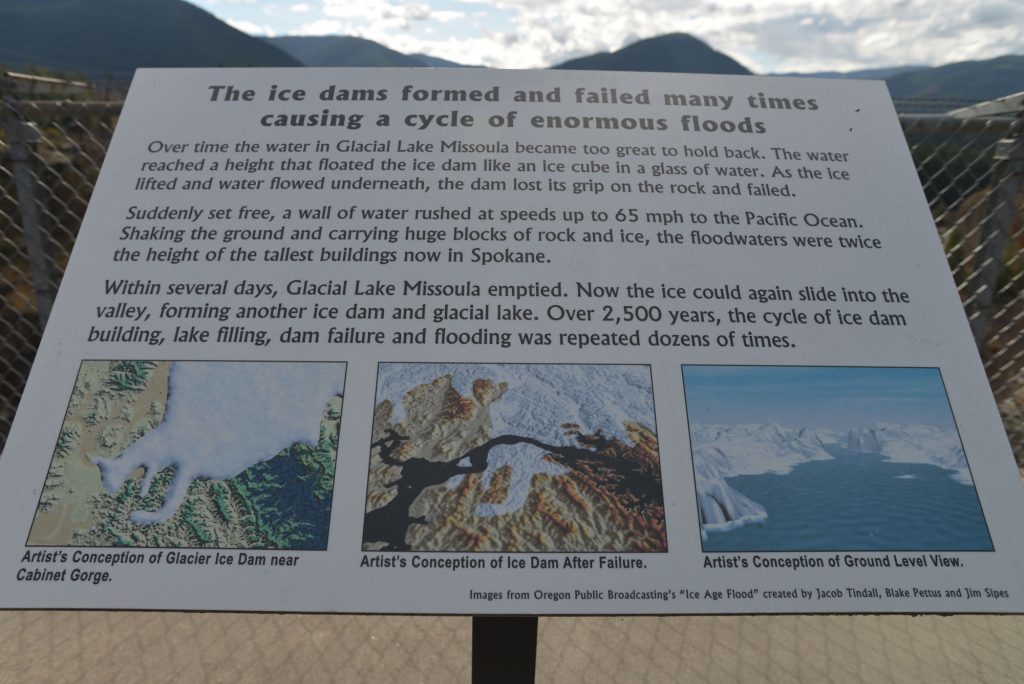
In the Kuhnian sense, therefore, we can see that the "multiple Missoula floods" model doesn't count as a true paradigm shift, any more than mealy-mouthed statements like "we are all catastrophists now" can be taken at face value. In short, as noted above, the Missoula model is best understood not as any kind of revolution but, on the contrary, as an attempt to save the gradualist paradigm from destruction by the overwhelming evidence of catastrophic flooding on the ground.
The history of science is littered with similar attempts to save old, failing paradigms from the weight of contradictory evidence. In Ptolemaic astronomy, for example, the earth was conceived of as standing at the center of the universe, with the sun and planets in orbit around it. But contradictory evidence kept emerging suggestive of another, truly revolutionary possibility that we now know to be correct - namely that the earth and the other planets orbit the sun.
Irregular and retrograde planetary motions were particularly hard to explain. For a millennium and a half, however, Ptolemaic astronomers contrived to save their hopelessly wrong geocentric paradigm from this threat with the ingenious notion of epicycles (in which it was envisaged that the planets not only orbited the earth but also moved in smaller circles as they travelled along the courses of their orbits). It was an attractive idea, and it seemed to explain a lot, but it was destined for the dustbin of history when one of the great paradigm shifts of all time unfolded in the 16th and 17th centuries as Copernican heliocentrism shifted from heresy to mainstream.
Without the strong contradictory evidence provided by Copernicus and his successors, the Ptolemaic model would probably have struggled on in one form or another for quite a bit longer. Under certain circumstances it might even have thrived. The new information, however, was fatal to it.
In just the same way, I suspect, new information that has entered the public domain since 2007 is likely to prove fatal to the "multiple Missoula floods" model and require science to do what Bretz called for from the beginning - namely to explore the truly revolutionary possibility that the channeled scablands of the Columbia Plateau witnessed the single largest flood that ever occurred on earth, that it was sudden, that it rose and fell within a few months, and that it occurred near the end of the last Ice Age.
Return of the cataclysm
Is it possible that something close to a conspiracy is at work in science to prevent the proper consideration and wide public uptake of catastrophist ideas?
We've seen what happened to J Harlen Bretz. The frosty and deeply unpleasant reception initially given to his findings, the years that he spent in academic limbo afterwards, the repeated, persistent efforts made by a host of scholars to dismiss his evidence entirely, or, failing that, to account for it by gradualist means, and then at last, years later, when all that had failed and the notion of outburst floods from Glacial Lake Missoula had offered itself as a solution, the realization that he had been right all along. But not right, not right under any circumstances, not right in any imaginable universe, on the issue of the single cataclysmic "debacle" that his instincts had originally led him to! If J Harlen Bretz was to be right, then it was necessary that he should be right in a politically-correct way - in other words, in a way that could be redacted by skilled uniformitarian spin-meisters to edit out any hint of a global catastrophe lurking between the lines!
Since 2007, however, hints of just such a catastrophe have returned, and with a vengeance, in the form of a new scientific theory, the Younger Dryas Impact Hypothesis, which "proposes that a major cosmic impact event occurred at the Younger Dryas Boundary (YDB) 12,800 years ago."52 The proponents of the hypothesis suggest that the agency was a giant comet that broke up into multiple fragments either before or during its entry into earth's atmosphere, and suggest also that North America was the epicenter of the resulting cataclysm with several of the largest fragments of the bolide impacting directly on the North American ice cap.
The epoch which geologists call the Younger Dryas (after a species of Alpine flower that flourishes in cold conditions) has long been recognized as mysterious and tumultuous. When it began 12,800 years ago the earth had been emerging from the Ice Age for roughly 10,000 years, global temperatures were rising steadily and the ice caps were melting. Then there was a sudden dramatic return to colder conditions - nearly as cold as at the peak of the Ice Age 21,000 years ago. This short, sharp deep freeze lasted for 1,200 years until 11,600 years ago when the warming trend resumed with incredible rapidity, global temperatures shot up again and the remaining ice caps quite quickly melted away, dumping all the water they contained into the oceans and raising sea level significantly all around the world.
What set these upheavals in motion?
The Younger Dryas Impact Hypothesis is a comprehensive attempt to answer that question and is the work of 63 highly-qualified scientists from 55 universities in 16 countries, collaborating as the Comet Research Group.53 Members include nuclear analytical chemist Richard Firestone of the Lawrence Berkeley National Laboratory, world-renowned oceanographer Jim Kennett of the University of California, Wendy Wollbach Professor of Inorganic Chemistry and Geochemistry at DePaul University, Albert Goodyear, Professor of Archaeology at the University of South Carolina, Geophysicist Allen West, Astrophysicist Malcolm Le Compte, Geologists James Teller and Ted Bunch - and more than 50 other leading researchers from a wide range of disciplines.54
Such a stellar assembly, cannot be dismissed as "lunatic fringe" - usually the easiest way for defenders of the gradualist status quo to denigrate catastrophists. Comet Research Group members, clearly, are not fringe people! On the contrary, they're as mainstream as can be, and they have adhered throughout to rigorous methods and protocols. The world of science has therefore been obliged to take their evidence seriously - even though it very clearly points in a dangerous and radical direction and, as Jim Kennett puts it: "challenges some existing paradigms within several disciplines."55
Ideas that challenge paradigms typically don't get official funding, so it's no surprise that Comet Research Group members have received none. This, however, has not deterred them from continuing with their research - which has been consistently of such high quality, yielding such striking results that the gradualist establishment has been unable to prevent publication in a wide range of prestigious scientific journals including the Proceedings of the National Academy of Sciences, the Journal of Geology, Quaternary International, and Nature's Scientific Reports. These in turn have led to stories in the scientific and popular press putting the information in front of a much wider audience.
The first headline that caught my eye was in the British magazine New Scientist of 22 May 2007 and asked provocatively: "DID A COMET WIPE OUT PREHISTORIC AMERICANS?"
At that time, 2007, I was taking a break from the lost civilization mystery that had absorbed my energies, and been the subject of so many of my books, for so long. The New Scientist article tweaked my curiosity, however, because it referred to the exact epoch that I had focused on in my books. The article didn't speak of a lost civilization, but began with a reference to the so-called "Clovis" culture of North America (named after the type site at Blackwater Draw near the town of Clovis, New Mexico, where the characteristic "fluted point" stone weaponry of the Clovis culture was first found).56 This culture mysteriously vanished from the archaeological record during the Younger Dryas between 12,800 and 11,600 years ago. The article addressed the mystery:
"The Clovis people flourishing some 13,000 years ago, had a mastery of stone weaponry that stood them in good stead against the constant threat of large carnivores, such as American lions and giant short-faced bears. It's unlikely, however, that they thought death would come from the sky.The article went on to explain that the sediment samples the team's evidence focussed on contained several different types of debris that could only have come from an extraterrestrial source, such as a comet or an asteroid. The debris included nanodiamonds, created by the shock and heat of impacts, tiny carbon spherules that form when molten droplets cool rapidly in air, and carbon molecules containing the rare isotope helium-3, far more abundant in the cosmos than on Earth.58
"According to results presented by a team of researchers this week at the American Geophysical Union meeting in Acapulco, Mexico, that's where the Clovis people's doom came from. Citing several lines of evidence, the team suggests that a wayward comet hurtled into Earth's atmosphere around 12,900 years ago [N.B. that date would later be revised downwards by a hundred years to 12,800 years ago], fractured into pieces and exploded in giant fireballs. Debris seems to have settled as far afield as Europe.
"Jim Kennett, an oceanographer at the University of California, Santa Barbara, and one of the team's three principal investigators, claims immense wildfires scorched North America in the aftermath, killing large populations of mammals and bringing an abrupt end to the Clovis culture. 'The entire continent was on fire,' he says.
"Lead team member Richard Firestone, a nuclear analytical chemist at the Lawrence Berkeley National Laboratory in California, says the evidence lies in a narrow 12,900-year-old carbon-rich layer of sediment found at eight well-dated Clovis-era sites and a peppering of sediment cores across North America, as well as one site in Belgium.
"Probed as to why no crater had yet been identified with this hypothetical impact 12,900 years ago, a third team member, Arizona-based geophysicist Allen West, suggested that smaller, low-density parts of the comet would have exploded in the atmosphere, while larger fragments might have crashed into the mile deep ice cap that covered North America at that time. 'Such craters,' West observed, 'would have been ice-walled and basically melted away at the end of the last ice age', leaving few traces."57
"'You might find some other explanation for these individually,' says Firestone, 'but taken together, it's pretty clear that there was an impact.' The team says the agent of destruction was probably a comet, since the key sediment layer lacks both the high nickel and iridium levels characteristic of asteroid impacts."59Last but not least, the New Scientist article confirmed, all the evidence pointed to North America as the epicentre of the disaster:
"Levels of the apparent extraterrestrial debris, for example, are highest at the Gainey archaeological site in Michigan, just beyond the southern reach of North America's primary ice sheet 12,900 years ago. Moreover, levels decrease the further you go from Gainey, suggesting that the comet blew up largely over Canada . . ."60In other words, largely over the ice cap that covered the northern half of North America during the Ice Age - the source of all the meltwater that scarred and hacked the scablands of Washington State in "Bretz's flood" (whether or not that meltwater came exclusively from Lake Missoula or gushed forth in far larger quantities than Lake Missoula, alone, could ever have held). Bretz himself, as we've seen, was forced to abandon his own strong intuition that there had been a single, massive meltwater flood in favour of multiple flushings of limited amounts of meltwater out of Lake Missoula again and again over thousands of years.
The primary reason he embraced this theory, however, was not that he had become a convert to gradualism, but because he was never able to explain how a large enough area of the ice-cap to supply all the vast amounts of water needed for his flood could simply have melted all at once. He had proposed two possibilities - dramatic overnight global warming on the one hand, or volcanic activity under the ice cap on the other - but, as the reader will recall, he very quickly conceded there was no evidence for either. What Bretz did not consider, and could not consider - because the relevant data only began to come in quarter of a century after his death - was the possibility that the ice cap could have undergone cataclysmic melting as a result of a comet impact.
If only Bretz had known . . .
A few months after the article appeared in New Scientist, the Comet Research Group published a detailed paper on their findings. It appeared in the prestigious Proceedings of the National Academy of Sciences (PNAS) on 9 October 2007. Despite the sober setting, the headline was dramatic:
"EVIDENCE FOR AN EXTRATERRESTRIAL IMPACT 12,900 YEARS AGO THAT CONTRIBUTED TO THE MEGAFAUNAL EXTINCTIONS AND THE YOUNGER DRYAS COOLING".'A carbon-rich layer,' summarised the team:
"dating to around 12,900 years ago, has been previously identified at Clovis-age sites across North America and appears contemporaneous with the abrupt onset of the Younger Dryas (YD) cooling. The in situ bones of extinct Pleistocene megafauna, along with Clovis tool assemblages, occur below this black layer but not within or above it. Causes for the extinctions, YD cooling, and termination of Clovis culture have long been controversial. In this paper, we provide evidence for an extraterrestrial (ET) impact event close to 12,900 years ago, which we hypothesize caused abrupt environmental changes that contributed to YD cooling, major ecological reorganization, broad-scale extinctions, and rapid human behavioural shifts at the end of the Clovis Period. Clovis-age sites in North America are overlain by a thin, discrete layer with varying peak abundances of (i) magnetic grains with iridium, (ii) magnetic microspherules, (iii) charcoal, (iv) soot, (v) carbon spherules, (vi) glass-like carbon containing nanodiamonds, and (vii) fullerenes with ET helium, all of which are evidence for an ET impact and associated biomass burning circa 12,900 years ago . . . . We propose that one or more large, low-density ET objects exploded over northern North America, partially destabilizing the Laurentide Ice Sheet and triggering YD cooling. The shock wave, thermal pulse, and event-related environmental effects (e.g., extensive biomass burning and food limitations) contributed to megafaunal extinctions . . ."61Nor were the mammoths, mastodons, ground sloths, horses, camels, giant beaver and other megafauna alone. In total, it is particularly striking that no less than thirty-five genera of mammals (with each genus consisting of several species) became extinct in North America between 12,900 and 11,600 years ago, i.e. precisely during the mysterious Younger Dryas cold event.62
Looking at the data, the implications of this new research were immediately obvious to me. What it offered, if it checked out, was an elegant and potentially revolutionary explanation both for the sudden onset of the Younger Dryas itself and for the accompanying extinctions, and perhaps for much else besides - including the cataclysmic flooding that left its scars on the channeled scablands of Washington State.
This seemed all the more plausible when I learned that Firestone, Kennett and West's proposal for their comet was that it was a conglomeration of impactors including one that might have been as much as 4 kilometers (2.5 miles) in diameter.63 Furthermore, that four-kilometer object would itself have been just one amongst multiple fragments resulting from the earlier disintegration - while still in orbit - of a giant comet up to 100 kilometers or more in diameter.64 Many of the fragments of the parent comet remained in orbit. Those that hit the earth at the onset of the Younger Dryas underwent further explosive fragmentation (accompanied by powerful airbursts that would themselves have had cataclysmic effects), as they entered the atmosphere over Canada.
Nonetheless, the authors thought it likely that a number of large impactors, up to two kilometers in diameter, would have remained intact to collide with the ice-cap.65 There, as West had earlier told New Scientist, any craters would have been transient, leaving few permanent traces on the ground after the ice had melted. "Lasting evidence," the PNAS paper added, "may have been limited to enigmatic depressions or disturbances in the Canadian Shield, e.g. under the Great Lakes, or Hudson Bay."66
Summarising the damage, the authors envisaged:
"a devastating, high-temperature shock wave with extreme overpressure, followed by underpressure, resulting in intense winds travelling across North America at hundreds of kilometers an hour, accompanied by powerful, impact-generated vortices. In addition, whether single or multiple objects collided with the earth, a hot fireball would have immersed the region near the impacts . . . At greater distances the re-entry of high-speed, superheated ejecta would have induced extreme wildfires which would have decimated forests and grasslands, destroying the food supplies of herbivores and producing charcoal, soot, toxic fumes and ash."67And how might all this have caused the dramatic cooling of the Younger Dryas? The authors offered many mechanisms operating together, amongst the most prominent of these being the huge plume of water vapour from the melted ice cap that would have been cast into the upper atmosphere, combined with immense quantities of dust and debris "composed of the impactor, ice-sheet detritus, and the underlying crust" as well as the smoke and soot from continent-wide wildfires.68 Taken in sum, it's quite easy to understand how so much lofted debris could, as the authors propose, "have led to cooling by blockage of sunlight"; meanwhile the water vapour, smoke, soot and ice would have promoted the growth of "persistent cloudiness and noctilucent clouds, leading to reduced sunlight and surface cooling . . . [thus reducing] the solar insolation at high latitudes, increasing snow accumulation and causing further cooling in the feedback loop."69
Severe and devastating enough in themselves, these factors nonetheless pale into insignificance when compared with the consequences of the hypothesized impacts on the ice cap:
"The largest potential effect would have been impact-related partial destabilization and/or melting of the ice -sheet. In the short term this would have suddenly released meltwater and rafts of ice into the North Atlantic and Arctic Oceans, lowering ocean salinity with consequent surface cooling. The longer-term cooling effects would have resulted largely from the consequent weakening of thermohaline circulation in the northern Atlantic, sustaining YD cooling for [more than] 1,000 years until the feedback mechanisms restored ocean circulation."70Impact-related partial destabilization and/or melting of the ice-sheet! And to such an extent that it was capable of disrupting the circulation of the world's oceans for more than a thousand years! What was envisaged here, clearly, was a cataclysm - a debacle! - on a truly massive scale. But what struck me most forcefully in the paragraph quoted above was that the authors had only considered the consequences of the huge quantities of icebergs and meltwater dumped into the oceans north, west and east of the North American epicenter of their proposed comet impacts. They did not consider the effects of that gigantic icy flood on the lands lying immediately south of the ice cap - which most certainly would not have been spared.
Once again I found myself wondering how J Harlen Bretz might have reacted if information about a possible comet impact had been at his disposal during his lifetime. I cannot prove it, of course, but I think he would have been much less likely to be distracted by Lake Missoula gradualism and much more likely - now that a credible heat source had been provided - to stick to his catastrophist guns. A single, cataclysmic meltwater flood on a truly gigantic scale coming directly off the ice cap to scour the scablands begins to look very feasible indeed in the light of the case made by Firestone, West, Kennett and the large team of scientists working with them.
Meanwhile my own hypothesis of an advanced civilization of prehistoric antiquity obliterated from the face of the earth during the Younger Dryas "window", is also strengthened by their work. For if their calculations are correct the explosive power of the Younger Dryas comet would have been of the order of ten million megatons.71That makes it two million times greater in its effects than the former USSR's Tsar Bomba, the largest nuclear weapon ever tested,72 and a thousand times greater than the estimated explosive power (10,000 megatons) of all nuclear devices stockpiled in the world today.73 A global disaster of such magnitude at exactly the time I suggested in my 1995 book Fingerprints of the Gods does not prove the existence of a lost civilization of the Ice Age but does at least provide us with a mechanism large enough - if such a civilization did exist - to have obliterated it almost entirely from human memory.
The evidence continues to mount
Since it has such important ramifications for almost everything we think we know about the safety and security of the earth's cosmic environment, and about our own past, it is reasonable to ask how solid the Younger Dryas comet impact theory really is. Since 2007, when it was first proposed, how has it stood up to scientific scrutiny and what new evidence has been brought forward in support of it?
The answer is that it has stood the test of time well and benefitted from a steady accumulation of new evidence set out in the proper way in the scientific literature and subject to rigorous peer review. There is neither space nor need, here, to explore this extensive literature in depth, but to give the general picture I will list the dates and titles of a few of the more important papers, with brief summaries of the conclusions and full references in the footnotes:
2008 (Quaternary Science Reviews):Taking on the dogmatic uniformitarians
Wildfire and abrupt ecosystem disruption on California's Northern Channel Islands at the Allerod-Younger Dryas Boundary. 'Evidence for ecosystem disruption at 13,000 to 12,900 years ago on these offshore islands is consistent with the Younger Dryas Boundary cosmic impact hypothesis.'74
2009 (Proceedings of the National Academy of Sciences):
Shock-synthesized hexagonal diamonds in Younger Dryas Boundary sediments. 'The presence of shock-synthesized hexagonal and other nanometer-sized diamonds in YDB sediments in association with soot and other wildfire indicators is consistent with a cosmic impact at 12,900 years ago, and the hypothesis that the Earth crossed paths with a swarm of comets or carbonaceous chondrites producing airshocks and/or surface impacts that contributed to abrupt ecosystem disruption and megafaunal extinctions in North America.'75
2010 (Journal of Glaciology; Monthly Notices of the Royal Astronomical Society; Sedimentary Geology):
Discovery of a nanodiamond-rich layer in the Greenland ice sheet. 'The presence of rounded nanodiamonds and lonsdaleite in Greenland ice suggests that a large cosmic impact occurred . . . The existence of this layer . . . ... appears consistent with the occurrence of a major impact event that correlates with the nanodiamond-rich YDB in North America at 12,900 years ago.'76
Palaeolithic extinctions and the Taurid Complex. 'Intersection with the debris of a large (50-100 km) short-period comet during the Upper Palaeolithic provides a satisfactory explanation for the catastrophe of celestial origin which has been postulated to have occurred around 12,900 years ago and which presaged a return to Ice Age conditions of about 1,300 years duration. The Taurid Complex appears to be the debris of this erstwhile comet; it includes about 19 of the brightest near-Earth objects.'77
Evidence for a Cosmogenic Origin of fired glaciofluvial beds in the Northwestern Andes: Correlation with Experimentally Heated Quartz and Feldspar. 'Fired sediment, considered equivalent to the "Black Mat" impact of 12,900 years ago has been located and analyzed in the Andes of Northwestern Venezuela. The "Black Mat" refers to possible fallout from the comet airburst presumed to have occurred over the Laurentide Ice Sheet, the impact spreading ejecta over large portions of North America and Europe, making it an interhemispheric event of considerable magnitude . . . The presence of copious monazite in the carbonaceous coatings is considered part of the incoming ejecta, as it is not a common indicator mineral in the local lithology . . . The intergrowth of carbonaceous "black mat" material with thermally disrupted and fragmented quartz and feldspar, a "welded" patina of 100-400nm thickness, could only occur with temperatures in excess of 900 degrees Centigrade, the event here interpreted to be of cosmogenic origin.'78
2011 (Earth & Planetary Science Letters):
Framboidal iron oxide: Chondrite-like material from the black mat, Murray Springs, Arizona. 'At the end of the Pleistocene a Younger Dryas "black mat" was deposited on top of the Pleistocene sediments in many parts of North America. A study of the magnetic fraction from the basal section of the black mat at Murray Springs, AZ, revealed the presence of amorphous iron-oxide framboids in a glassy iron-silica matrix. [Our] data suggest that the observed textures are . . . due . . . to a shock event that fractured and largely amorphised the grains . . . Therefore, we argue that these particles are the product of a hypervelocity impact event.'79
2012 (Proceedings of the National Academy of Sciences; Proceedings of the National Academy of Sciences):
Evidence from central Mexico supporting the Younger Dryas extraterrestrial impact hypothesis. 'We report the discovery in Lake Cuitzeo in central Mexico of a black, carbon-rich lacustrine layer, containing nanodiamonds, microspherules, and other unusual materials that date to the early Younger Dryas . . . We . . . find the evidence cannot be explained by any known terrestrial mechanism. It is, however, consistent with the Younger Dryas Boundary impact hypothesis postulating a major extraterrestrial impact involving multiple airbursts and/or ground impacts at 12,900 years ago.'80
Very high-temperature impact melt products as evidence for cosmic airbursts and impacts 12,900 years ago. 'We examined sediment sequences from 18 dated Younger Dryas boundary (YDB) sites across three continents . . . All sites display abundant microspherules in the YDB with none or few above and below. In addition, three sites . . . display vesicular, high-temperature siliceous scoria-like objects, or SLO's, that match the spherules geochemically . . . Our observations indicate that YDB objects are similar to material produced in nuclear airbursts, impact crater plumes and cosmic airbursts, and strongly support the hypothesis of multiple cosmic airbursts/impacts at 12,900 years ago. Data presented here require that thermal radiation from air shocks was sufficient to melt surface sediments at temperatures up to or greater than the boiling point of quartz (2,200 degrees centigrade).'81
2013 (Proceedings of the National Academy of Sciences; Journal of Geology):
Large Pt anomaly in the Greenland ice core points to a cataclysm at the onset of Younger Dryas. 'One explanation of the abrupt cooling episode known as the Younger Dryas (YD) is a cosmic impact or airburst at the YD boundary that triggered cooling and resulted in other calamities. We tested the YD impact hypothesis by analyzing ice samples from the Greenland Ice Sheet Project 2 (GISP2) ice core across the Bolling-Allerod/YD boundary for major and trace elements. We found a large platinum (Pt) anomaly at the YDB . . . Circumstantial evidence hints at an extraterrestrial source . . . [perhaps] a metal impactor with an unusual composition . . .'82
New Evidence from a Black Mat Site in the Northern Andes Supporting a Cosmic Impact 12,800 years ago. 'The spherules from Venezuela are morphologically and compositionally identical to YDB spherules documented elsewhere . . . on three continents, North America, Europe and Asia, confirming the YDB magnetic spherule results of previous researchers. Their microstructural texturing indicates they formed from melting and rapid quenching . . . Thus the most likely origin of the spherules seems to be by cosmic impact/airburst 12,800 years ago with interhemispheric consequences. The site in Venezuela, along with one in Peru, are the two southernmost sites currently known to display evidence for the YDB impact event, and these sites represent the first evidence that the effects of the impact event extended into South America, even into the Southern Hemisphere.'83
2014 (Journal of Geology):
Nanodiamond-Rich Layer across Three Continents Consistent with Major Cosmic Impact at 12,800 Cal BP. 'A major cosmic-impact event has been proposed at the onset of the Younger Dryas cooling episode at 12,800 years (plus or minus 150 years) before the present, forming the Younger Dryas Boundary (YDB) Layer distributed across up to 50 million square kilometers on four continents. In 24 dated stratigraphic sections in 10 countries of the Northern Hemisphere, the YDB layer contains a clearly-defined abundance peak in nanodiamonds (NDs), a major cosmic impact proxy . . . The large body of evidence now obtained about YDB NDs is strongly consistent with an origin by cosmic impact around 12,800 years ago and is inconsistent with formation of YDB ND by natural terrestrial processes, including wildfires, anthropogenesis, and/or influx of cosmic dust.'84
By 2014, after seven years of publishing their data in leading scientific journals, and with such an impressive accumulation of evidence, one would have thought that the Younger Dryas impact theory should, by now, be fully accepted and that researchers would have moved on to a broader consideration of the implications of such a recent and hitherto unsuspected global cataclysm for our understanding of the history of the earth and of our own species. However, we've already seen from the example of J Harlen Bretz how scientists wedded to the uniformitarian and gradualist reference frame react with extreme negative force to catastrophist theories.
Nor was Bretz an exception. Alfred Wegener, who first proposed the notion of continental drift - plate tectonics - was similarly pilloried, as, subsequently, were Luis and Walter Alvarez (the Chicxulub, 'K-T' impact), Steven J. Gould (punctuated equilibrium), Victor Clube and Bill Napier (coherent catastrophism), and James Lovelock, Sherwood Rowland, Mario Molina and Lynn Margulis for their contributions to geophysiology and the Gaia theory. It should come as no surprise, therefore, that Richard Firestone, Allen West, James Kennett and others who have followed the evidence and stuck their necks out to suggest that a comet impact caused the Younger Dryas, have also come under sustained and bitter attack.
Indeed the triumphant crowing of critics who clearly believe they have done away, once and for all, with the heretical catastrophism of Firestone, West and Kennett, has filled the academic air several times in the past few years. On each occasion you can almost hear the collective sigh of relief as if to say "thank God; we finally got those bastards"; but then a few months later comes the devastating and absolutely convincing refutation that forces the critics back to the drawing board.
It's quite noticeable, reviewing the literature, that academics form themselves into gangs. The ringleaders in the "anti-YD-impact" camp, whose names appear frequently at the top of critical articles, include Mark Boslough, a physicist on the technical staff of Sandia National Laboratories, Nicholas Pinter, a geology professor at Southern Illinois University, Tyrone Daulton, a research physicist at Washington University's Institute of Materials Science and Engineering, and Todd Surovell, an archaeologist at the University of Wyoming.
In 2012 they teamed up with half a dozen colleagues to publish a paper entitled "Arguments and Evidence Against a Younger Dryas Impact Event".'85 And a year earlier Pinter, Daulton and some of the authors of the 2012 attack had joined forces to write a paper hubrisistically entitled: "The Younger Dryas Hypothesis: A Requiem".86
To paraphrase Mark Twain, reports of the death of the comet theory had been greatly exaggerated.
For example, one of the key critiques made in the 2012 paper was that:
"Magnetic microspherule abundance results published by the impact proponents have not been reproducible by other workers. Analyses of the same YD site stratigraphy by Surovell et. al. [2009] could not replicate observations for two of the impact markers published by Firestone et. al. [2007]. The study by Surovell et. al. [2009] found no peaks of abundance unique to the YD time interval."87But the impact proponents were later able to show that the authors of the 2012 paper "neglected to cite nine independent spherule studies on two continents that reported finding significant YDB [Younger Dryas Boundary] spherule abundances."88 More damning, though, was the fact that when other scientists repeated the analysis of Surovell et. al., their findings did indeed support an impact. The scientists concluded that:
"the inability of Surovell et. al. to find YDB spherule peaks resulted from not adhering to the prescribed extraction protocol. For example, Surovell et. al., did not conduct any analyses using scanning electron microscopy, a necessary procedure clearly specified by Firestone et. al."89A separate independent study by Macolm LeCompte, Christopher Moore and others noted that the authors of the 2012 paper "collected and analysed samples from seven YDB sites, purportedly using the same protocol as Firestone et .al., but did not find a single spherule in YDB sediments at two previously reported sites.'90 LeCompte et al. set out to examine this discrepancy. After a thorough investigation of all the evidence their results cast the conclusions of the 2012 paper into even deeper shadow:
"We conducted an independent blind investigation of two sites common to both studies, and a third site investigated only by Surovell et .al. We found abundant YDB microspherules at all three widely separated sites consistent with the results of Firestone et al. and conclude that the analytical protocol employed by Surovell et al. deviated significantly from that of Firestone et al. Morphological and geochemical analysis of YDB spherules suggest they . . . formed from abrupt melting and quenching of terrestrial materials and . . . are consistent with . . . a previously proposed cosmic impact 12,900 years ago . . ."91Unsurprisingly, after all this, Pinter and Daulton's 2011 "requiem" for the Younger Dryas impact hypothesis turned out to have been premature. In this paper they claimed to have sampled the YDB layer at a location "identical or nearly identical" with the location reported by Kennett et al., as part of three studies that reported finding no YDB spherules or nanodiamonds. However, they are rightly taken to task by James Wittke and others in a paper in PNAS in 2013 which investigated their evidence and found that it was not at all what it claimed to be:
"the published Universal Transverse Mercator coordinates reveal that their purported continuous sequence is actually four discontinuous sections. These locations range in distance from the site investigated by Kennett et. al. by 7,000 m, 1,600 m, 165 m, and 30 m, clearly showing that they did not sample the YDB site of Kennett et al. Furthermore, this sampling strategy raises questions about whether Pinter et al. sampled the YDB at all, and may explain why they were unable to find peaks in YDB magnetic spherules, carbon spherules, or nanodiamonds."92In 2012-12103, in an effort to limit the scope for poor or misleading scholarship to be cited as though it discredits their work - when in fact it does no such thing - Jim Kennett, Richard Firestone, Allen West and a formidable group of pro-impact scientists launched "one of the most comprehensive investigations of spherules ever undertaken".93 The investigation focussed on eighteen sites across North America, Europe and the Middle East (the latter represented by Abu Hureyra in Syria), and conducted more than 700 analyses on spherules using energy dispersive X-ray spectroscopy for chemical analysis and scanning electron microscopy for surface microstructural characterization.
The results, published in PNAS on 4 June 2013, took advantage of recent advances in radiocarbon technology to refine the date of the Younger Dryas impact from 12,900 to 12,800 years ago94 and enabled a much more detailed map of the YDB field to be drawn up, covering close to 50 million square kilometres of North, Central and South America, a large segment of the Atlantic Ocean, and most of Europe, North Africa and the Middle East. Calculations indicate that the impact deposited around ten million tonnes of spherules across this vast strewnfield.95 Nor, was there any doubt in the researchers' minds that an impact had been at the heart of the matter:
"The analyses of 771 YDB objects presented in this paper strongly support a major cosmic impact at 12,800 years ago . . . Spherules . . . are (i) widespread at 18 sites on four continents; (ii) display large abundance peaks only at the YD onset at around 12,800 years ago; (iii) are rarely found above or below the YDB, indicating a rare event; and (iv) amount to an estimated 10 million tonnes of materials distributed across around 50 million square kilometres of several continents, thus precluding a small, local event."96Despite the annoying ability of the Younger Dryas comet to keep on proving itself, and of its proponents to keep on refuting all attacks, Nicholas Pinter, lead author of the 2011 "Requiem" paper, felt moved in an interview with NBC News in September 2013 to attempt yet again to cast the hypothesis into scientific limbo. "My only comment," he said, "is that the pro-impact literature is, at this point, fringe science being promoted by a single journal."97
A number of observers with no particular axe of their own to grind were puzzled by this remark. First of all, as National Geographic correspondent Robert Kunzig noted, it smacked a little of wishful thinking, even desperation, on Pinter's part. "Some opponents of the hypothesis," wrote Kunzig, '"want so badly for it to go away that they have attempted to declare it dead."98 Secondly, the journal that Pinter accused of promoting fringe science was none other than the revered, utterly mainstream, and extensively peer-reviewed Proceedings of the National Acadeamy of Sciences (PNAS).99 Thirdly, although a number of articles by Kennett, West, Firestone and their team have appeared in PNAS, it is simply not true to suggest that PNAS is promoting their cause. On the contrary, at the time Pinter blurted out his protest to NBC the critics of the YD comet hypothesis had published ten times in PNAS, whereas the proponents of the hypothesis had published there only eight times. Likewise Pinter's claim that the hypothesis is only being presented in a single journal could hardly be more wrong. By September 2013, in addition to their eight papers in PNAS, proponents had published no less than fifteen papers in thirteen other journals.100
The scholarly fight over the Younger Dryas impact hypothesis (YDIH) is far from over. After Pinter and Daulton's attacks in 2011 and 2012, and after the comprehensive refutation of their criticisms in 2013, the next assault by critics of the hypothesis appeared in PNAS in May 2014 and was entitled "Chronological evidence fails to support claim of an isochronous widespread layer of cosmic impact indicators dated to 12,800 years ago". Reading the paper one could easily be led to believe that it dealt a death blow to the YDIH:
"According to the Younger Dryas Impact Hypothesis (YDIH), ∼12,800 calendar years before present, North America experienced an extraterrestrial impact that triggered the Younger Dryas and devastated human populations and biotic communities on this continent and elsewhere. This supposed event is reportedly marked by multiple impact indicators, but critics have challenged this evidence, and considerable controversy now surrounds the YDIH. Proponents of the YDIH state that a key test of the hypothesis is whether those indicators are isochronous and securely dated to the Younger Dryas onset. They are not. We have examined the age basis of the supposed Younger Dryas boundary layer at the 29 sites and regions in North and South America, Europe, and the Middle East in which proponents report its occurrence. ... Only 3 of the 29 sites fall within the temporal window of the YD onset as defined by YDIH proponents. The YDIH fails the critical chronological test of an isochronous event at the YD onset..."As ever the critics were over-eager. When their seemingly devastating claims of non-synchronous dates were investigated they could not be substantiated and a mass of new evidence emerged supporting the view that a single, very large-scale, very rapid event, "a moment in time called an isochron", had indeed occurred.101 In July 2015, therefore, PNAS published a full refutation based on 354 dates from 23 stratigraphic sections in 12 countries on four continents under the title "Bayesian chronological analyses consistent with synchronous age of 12,835 - 12,735 Cal B.P. for Younger Dryas boundary on four continents". These dates, the study concludes, support "a causal connection between the impact event and the Younger Dryas."102
Such exchanges amongst scientists often take a long time to resolve, with the result that erroneous claims - as in the May 2014 paper - can remain on the record sometimes for a year or more before being corrected. Another example, which was published online on 16 December 2014 and in print in January 2015 in the Journal of Archaeological Science, is a paper by P. Thy, G. Willcox, G.H. Barfod and D.Q. Fuller, entitled "Anthropogenic origin of siliceous scoria droplets from Pleistocene and Holocene archaeological sites in northern Syria".103 The essence of the argument in this paper is that siliceous scoria droplets (composed mostly of glass matrix and bubbles together with partially melted mineral grains) from Abu Hureyra in Syria - cited by pro-impact scientists as evidence for their case - were nothing to do with the comet but were instead a product of ancient buildings destroyed by house fires:
"We therefore conclude that melting of building earth in ancient settlements can occur during fires reaching modest temperatures. There is no evidence to suggest that siliceous scoria droplets result from very high temperature melting of soil and are the result of a cosmic event."104"For the Syria site the impact theory is out," boasted lead author Peter Thy in a press interview headlined "Study Casts Doubt on Mammoth-Killing Cosmic Impact".105 Yet it seems that, once again, the bluster was premature. Allen West is listed as the corresponding author on the majority of scholarly papers published by the team of scientists working on the Younger Dryas impact, so I emailed him to ask if he and his colleagues had any response to the critique by Thy et al. West replied as follows:
"We agree with Thy et al. that hut fires can produce glass, but it does not follow, therefore, that all glass comes from hut fires, as they conclude. We have analysed natural glasses supplied by one of the authors of that study, and the 12,800-year-old glass from Syria is only superficially similar. Instead it matches known cosmic impact glass, as well as high-temperature atomic bomb glass.When the new paper by West and his colleagues is completed - scheduled for the latter half of 2017107 — I have no doubt that it will, effectively, refute the arguments of Thy et al. - just as all previous attacks have been successfully refuted. But I also have no doubt that those, who for whatever reasons of their own are philosophically opposed to the notion of a cataclysm 12,800 years ago, will publish yet more so-called "requiems" for the Younger Dryas impact hypothesis in the years ahead, even while the constant discovery of new evidence means that it continues to thrive and grow. Indeed the most recent salvos in the ongoing scientific war took place in late 2016 and early 2017 and fully confirmed this trend.
"Most importantly, those authors did not discuss or look for the evidence of abundant high-temperature minerals presented in our previous papers on three sites on two continents (Pennsylvania, South Carolina and Syria) where we found suessite that melts at around 2,300 degrees Centigrade and corundum at around 1,800 degrees Centigrade. Now we have even stronger evidence from the Syrian site and are working on a new paper... The 12,800-year-old Syrian glass contains a range of minerals that melted at extraordinarily high temperatures. See the table below from our new paper:
"Those temperatures are sufficient to melt steel. Furthermore the same glass-rich layer at the Syrian site contains large peaks in nanodiamonds, nickel and platinum. No building fire can duplicate that range of evidence - such fires can't produce nanodiamonds or platinum enrichments. All this evidence refutes the hypothesis of Thy et al. that this glass was produced in low-temperature building fires."106
Thus on 19 December 2016 the Journal of Quaternary Science published two papers co-authored by Nicholas Pinter and Tyrone Daulton - who the reader will by now recognise as long-term critics and opponents of the Younger Dryas impact hypothesis. Andrew Scott is also listed as a co-author on the first paper and as lead author on the second paper.
Entitled "Comprehensive analysis of nanodiamond evidence relating to the Younger Dryas Impact Hypothesis", the first paper rakes over some very old (and long ago refuted) chestnuts favoured by Pinter and Daulton when it finds "no evidence for londsdaleite in YDB sediments and... no evidence for a spike in nanodiamond concentration at the YDB layer to support the impact hypothesis."108 Predicatably, the second paper, "Interpreting palaeofire evidence from fluvial sediments: a case study from Santa Rosa Island, California, with implications for the Younger Dryas Impact Hypothesis," also finds "no evidence for an extraterrestrial impact".109
Given the slow process of academic publishing, a year or more may elapse before the Comet Research Group is able to respond fully to these papers. In January 2017, however, members of the group released the following initial comments (in which the first paper is referred to as "Daulton et al" and the second paper as "Scott et al":
1. NANODIAMONDS. The Daulton et. al. paper makes it sound like there is no evidence for nanodiamonds at all, when in fact they admit to the opposite. On page 22, they write, "While there is evidence of cubic nanodiamonds in Late Pleistocene sediments, their presence does not provide evidence of an impact because they have not been linked to impact processes." The only way they can make that claim is to ignore all of the other evidence that we have such as high-temperature melted spherules and meltglass.In line with the ups and downs that we have documented so far, recent papers have not been confined to Daulton and Pinter's ongoing project to discredit the Younger Dryas impact hypothesis, nor even to the Comet Research Group's initial response to the December 2016 papers, but have also included papers by other scientists that are highly supportive of the hypothesis.
LONSDALEITE. We wrote in Kinzie et al. (2014) that YDB "lonsdaleite-like" particles have all the characteristics of lonsdaleite, but there are too few of them for us to confirm that. We agree with Dalton that these particles are still debatable, and we agree that we misidentified some of them, but not all.
PEAKS IN NANODIAMONDS. Daulton disputes that we have identified peaks in nanodiamonds, but frankly, that is just a nonsensical argument. While it is true that we cannot tell how many nanodiamonds are in the peaks, nevertheless, we know that there are qualitative peaks. Here's a real world example of why Daulton is wrong. Let's say that I look out the window onto a pond and I don't see any ducks. Next day, I look out and there are lots of ducks. There are too many to count, but I know that there are a lot more than zero. The next day the ducks are gone. By definition, there was a peak in ducks on the previous day. The same applies to Daulton's claim that we don't have a peak in nanodiamonds. He is simply wrong - the peak has been confirmed by independent groups, including Bement et al. in Oklahoma and in Belgium by Tian et al., who are critics of the YDB hypothesis.
NANODIAMONDS AND IMPACTS. Daulton and others keep repeating "Yes, the diamonds are there but that doesn't prove there was an impact." While that is true, technically, there is no other known way to have nanodiamonds appear in sediment except by an impact. To use the same analogy as above, if they look like ducks, they probably are.
2. The Scott et al. paper looked for wildfire evidence in just one area, the Channel Islands in California. They found lots of charcoal and carbon spherules in many strata, and they state on page 11, "Carbonaceous materials from Arlington Canyon do not require extraterrestrial input or ignition, or in some cases preclude such an event," in contradiction to their press release, which makes it seem like they have completely refuted the YDB hypothesis. Just to be clear, they're saying that they can't rule out an extraterrestrial impact. They also argue that the carbonaceous materials indicate low-temperature wildfires which, they assume, precludes extraterrestrial impacts. That assumption just shows their lack of knowledge of impact wildfires, such as those that occurred at Tunguska in 1908, where low-temperature wildfires were triggered beneath the fireball. At Tunguska, the highest temperatures were generated closest to the fireball, and temperatures dropped off exponentially with distance, meaning that at Tunguska and presumably, any other impact event, there are both high-and low-temperature fires.
Of these, the first, by research chemist Antonio Zamora, is entitled "A model for the geomorphology of the Carolina Bays" and was published online in January 2017 in the journal Geomorphology, ahead of the April 2017 print edition.110 The second paper, co-authored by Christopher Moore, Allen West, Malcolm LeCompte and others, is entitled "Widespread platinum anomaly documented at the Younger Dryas onset in North American sedimentary sequences" and was published on 9 March 2017 in Nature's Scientific Reports.111
Let's begin with the paper on the platinum anomaly discovered across North America which has the potential, in itself, to settle the debate around the Younger Dryas impact hypothesis definitively in favour of the proponents of the hypothesis. This is the case because, as Christopher Moore, lead author of the study comments, "Platinum is very rare in the Earth's crust, but it is common in asteroids and comets,"112 and because the newly discovered North American platinum anomaly dates precisely from the Younger Dryas Boundary 12,800 years ago and reinforces an earlier study (by Pataev et al) which found an identical platinum anomaly at the identical date in Greenland ice cores.113
"Previously," Moore et al. note, "a large platinum (Pt) anomaly was reported in the Greenland ice sheet at the Younger Dryas boundary (YDB) (12,800 Cal B.P.). In order to evaluate its geographic extent, re-assay and inductively coupled plasma mass spectrometry (FA and ICP-MS) elemental analyses were performed on 11 widely separated archaeological bulk sedimentary sequences. We document discovery of a distinct Pt anomaly spread widely across North America and dating to the Younger Dryas (YD) onset. The apparent synchroneity of this widespread YDB Pt anomaly is consistent with Greenland Ice Sheet Project 2 (GISP2) data that indicated atmospheric input of platinum-rich dust... This study finds no evidence to contradict the conclusions of Petaev et al. that the Greenland Pt enrichment most likely resulted from an extraterrestrial source... In addition, our findings show no contradiction with the Younger Dryas impact hypothesis."114
The language is cautious and understated but the implications for critics of the Younger Dryas impact hypothesis are profound. Those critics have spent years splitting hairs and picking nits in their efforts to contest the nanodiamond, microspherule, synchroneity and other evidence put forward by proponents of the hypothesis, but now, suddenly, across North America, they find themselves confronted by a widespread platinum anomaly - clear and unambiguous evidence of a cosmic impact - at the Younger Dryas boundary. If the debate around this subject were purely objective and rational, the Pt layer should, at a stroke, take all the other evidence of impact out of the "disputed" category, where Daulton, Pinter and others have tried so hard to constrain it, and move it decisively into the "accepted" category. This, in turn, would open the way - at last! - for proper consideration of the implications for the paradigms in various disciplines that will have to be revised, or completely discarded, in the light of the impact evidence. An extinction-level event just 12,800 years ago really does change everything in fields as varied as astronomy, paleo-oceanography, paleo-climatology, geology, and - of the greatest significance for our purposes here - archaeology. This becomes all the more obvious in the light of the second of the two 2017 papers, Antonio Zamora's "Model for the geomorphology of the Carolina Bays", which adds greatly to our understanding of the truly cataclysmic and earth-changing nature of the Younger Dryas impacts.
To be clear, the proponents of the hypothesis have always argued that the most plausible agent of the cataclysm was a disintegrating giant comet. According to their calculations, at least four of its largest fragments - in some cases more than a kilometer in diameter - impacted directly, with a kind of "scatter-gun" effect, at different points on the North American ice cap. The trajectory of the incoming fragments was roughly east to west and some remained aloft long enough to cross the Atlantic ocean and hit the northern European ice cap with further impacts traced eastward at least as far as Syria.
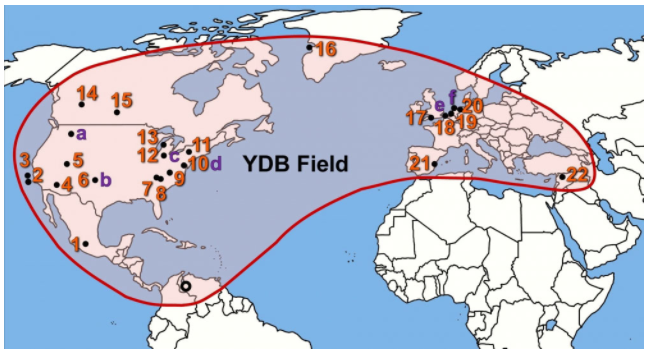
Zamora takes up the case, drawing our attention to two extensive but previously unexplained features of the North American landscape - the so called "Nebraska Rainwater Basins" in the Midwest and the so-called "Carolina Bays" in the Southeast. The two regions are widely separated geographically, but in both cases we are confronted by huge numbers of large, very similar and often overlapping geometrical elliptical depressions in the earth that first became apparent from aerial surveys undertaken during the 20th century. The orientation of the "Basins" is from northeast to southwest and the orientation of the "Bays" is from northwest to southeast but, as Zamora puts it, the elliptical shape of the "Basins" is so similar to that of the "Bays" that "it is necessary to consider that they formed contemporaneously with the Carolina Bays by the same mechanisms."116
Zamora then gives a brief synopsis of the Younger Dryas impact hypothesis, with its proposal that at least four large comet fragments impacted at various points across the North American icecap. He notes that in 2009-2010 there were attempts by the proponents of the hypothesis to argue that the strikingly regular orientation of the Carolina Bays was consistent with their formation by a shockwave coming from vicinity of the Great Lakes - which were not lakes 12,800 years ago but deeply buried depressions entirely covered by the icecap.117 However, their arguments and evidence were dismissed by Pinter, Daulton and others in their 2011 "Requiem" paper which, though subsequently refuted as to nanodiamonds and microspherules, made reasonable and seemingly irrefutable points about the Carolina Bays. Despite the initial promise suggested by their orientation, subsequent investigations failed to identify any trace of meteoritic material within the bays themselves and - even more damningly — indicated that the bays were of widely differing ages and therefore could not have been formed by a single event 12,800 years ago.118
There the matter would have been allowed to lapse into obscurity were it not for Antonio Zamora who decided to explore a hitherto neglected possibility - namely that the Carolina Bays, and also the Nebraska Rainwater Basins, had been caused by secondary impacts of ejecta thrown up from one of the primary impact sites on the North American icecap.119 In constructing his hypothesis, Zamora references the work of two earlier researchers, orbital analysts Michael E. Davias and Thomas Harris. They deployed the science of ballistics and triangulation to demonstrate that an impact over the enigmatic and now water-filled inlet presently known as Saginaw Bay, Michigan (which, as the reader will recall, was not a bay 12,800 years ago but solid land covered by glacial ice a mile deep) would have produced ejecta and secondary impacts in a "butterfly-wing" pattern precisely over the Nebraska Rainwater Basins, to the southwest, and the Carolina Bays to the southeast.120
Davias and Harris describe Saginaw Bay (see illustration below) as the result of "a unique singular event that cuts through the central bedrock". While conceding that the bay is "commonly attributed to erosion by the Saginaw glacial lobe penetrating through the Mississippian and Pennsylvanian Cuestas" they note that it shows many of the characteristics that we would expect of a structure caused by a large oblique impact on glacial ice with shock effects passing through the icecap and into the bedrock below.121
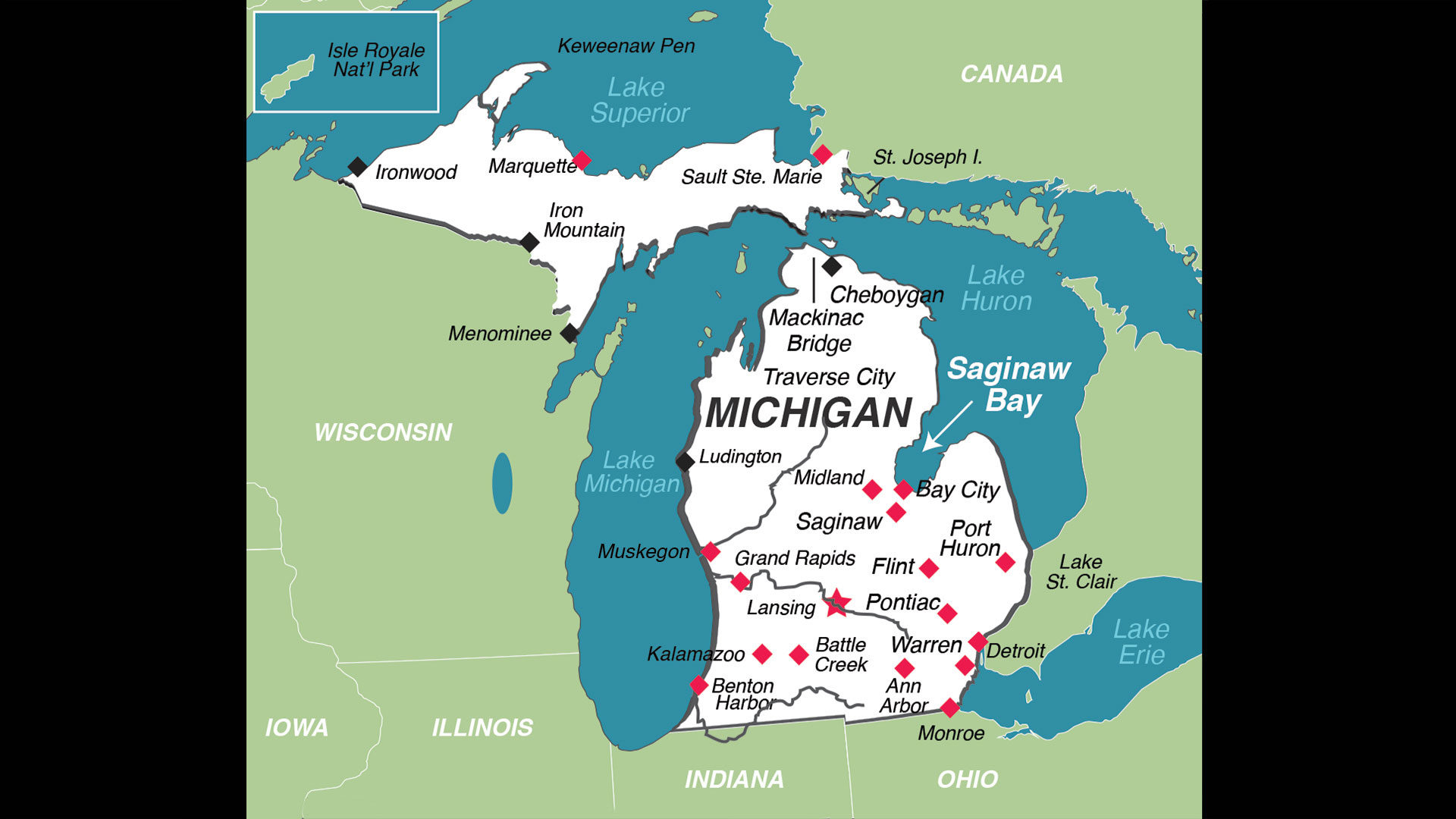
"The Laurentide Ice Sheet covered the convergence point determined by Davias and Harris (2015) in Saginaw Bay with a thickness of approximately 1500 to 2000 m of ice during the Pleistocene. An impact by a meteorite at this location would have ejected chunks of ice in ballistic trajectories, and the heat of the impact would have melted some ice to produce water and steam. The Glacier Ice Impact Hypothesis describes four processes that must have occurred in a specific sequence for the creation of the Carolina Bays"123:"Experiments of high-speed impacts on ice sheets using NASA's Ames Vertical Gun," Zamora goes on to report, "demonstrate that ice shatters when a projectile hits it. Pieces of ice are ejected radiating from the impact site in ballistic trajectories and the icy layer reduces the extent of subsurface damage124..."
- Extraterrestrial impact ejects glacier ice boulders in ballistic trajectories;
- Secondary impacts liquefy unconsolidated soil;
- Oblique impacts on liquefied soil create slanted, conical cavities
- Viscous relaxation converts cavities into shallow, elliptical bays.
We've already seen that Michigan's Saginaw Bay is a likely candidate structure for the primary extraterrestrial impact envisaged by Zamora's hypothesis. As to Nebraska and the Carolinas, he notes that "ballistic equations, scaling laws relating crater size to impact energy, geometrical analysis and statistical analysis provide a mathematical foundation for explaining the shape of the bays and their origin from secondary impacts of glacier ice ejected from the Laurentide Ice Sheet that covered Michigan."125
Having reviewed and rejected all other explanations for the formation of the bays and basins by wind or water, Zamora therefore concludes as follows:
"The radial orientation of the Carolina Bays and Nebraska Rainwater Basins toward a convergence point in Michigan, and the elliptical shapes of the bays with specific width-to-length ratios can be better explained by impact mechanisms than by terrestrial wind and water processes.Zamora addresses the issue of the great diversity of dates for the Carolina Bays obtained by Optically Stimulated Luminescence (OSL), noting that this has hitherto been the most significant barrier to acceptance of the impact hypothesis with reference to the Bays. As he rightly points out, however, the basic assumption behind the use of OSL has been that the subsurface of the Carolina Bays was exposed to light at the time of bay formation. His experimental model refutes this by demonstrating that impacts on viscous surfaces are plastic deformations that do not expose the subsurface to light:
"The Glacier Ice Impact Hypothesis... has been supplemented with an experimental model demonstrating that oblique impacts on viscous surfaces can reproducibly create inclined conical cavities that are remodeled into shallow elliptical depressions by viscous relaxation. This makes it possible to model the Carolina Bays and Nebraska Rainwater Basins as conic sections whose width-to-length ratio can be explained by the angle of impact. Unlike the eolian and lacustrine hypotheses of bay formation that cannot be tested, the impact hypothesis uses mathematics and a physical model that can be used to demonstrate stratigraphic restoration by viscous relaxation and the remodeling of conical impact cavities on viscous media."126
"Therefore, OSL can only determine the date of the terrain, but not the date of formation of the bays. If all the Carolina Bays and Nebraska Rainwater Basins formed contemporaneously, it will be necessary to find a different way of dating them.Finally, and chillingly, Zamora's paper in Geomorphology notes:
"The Glacier Ice Impact Hypothesis explains all the features of the Carolina Bays and Nebraska Rainwater Basins, including their elliptical shape, radial orientation, raised rims, undisturbed stratigraphy, absence of shock metamorphism, overlapping bays, and the occurrence of bays only in unconsolidated ground."127
"The great surface density of the bays indicates that they were created by a catastrophic saturation bombing with impacts of 13 kt to 3 MT that would have caused a mass extinction in an area with a radius of 1500 km from the extraterrestrial impact in Michigan. This paper has considered mainly the ice boulders ejected by an extraterrestrial impact on the Laurentide Ice Sheet during the Pleistocene, but the impact would also have ejected water and produced steam. Taking into consideration the thermodynamic properties of water, any liquid water ejected above the atmosphere would have transformed into a fog of ice crystals that would have blocked the light of the sun. Thus, the time of formation of the Carolina Bays and Nebraska Rainwater Basins must coincide with an extinction event in the eastern half of the United States and the onset of a period of global cooling. This combination of conditions is best met by the disappearance of the North American megafauna, the end of the Clovis culture and the onset of the Younger Dryas cooling event at 12,800 cal. BP. The report of a platinum anomaly typical of extraterrestrial impacts at the Younger Dryas Boundary supports this scenario."128In Killer Comet, a book published in 2016, Zamora elaborates on the extent and true horror of the Younger Dryas cataclysm. He considers how the effects of the primary impact over Michigan would have been massively compounded by the secondary impacts of glacier ice boulders across the Carolinas. It's instructive to spend a few moments with the disturbing scenario that follows:
"All living things within 100 kilometers of the [Michigan] impact died instantly. They were either burned by the heat blast or killed by the shock wave. [In the Carolinas], 1000 kilometers from the impact zone, the blinding flash on the horizon was followed by a sky that darkened ominously as it filled with the giant ice boulders ejected by the impact. Three minutes after the flash, the dark sky advanced relentlessly, and the ground shook as the first seismic waves from the extraterrestrial impact site arrived travelling at 5 km/sec.To this apocalyptic picture, which traces the origin of the Carolina Bays to a large fragment of the disintegrated Younger Dryas comet hitting the North American icecap over what is now Saginaw Bay and throwing out a devastating barrage of ice boulders, must be added the implications of primary impacts by other fragments of the same comet at other points across the icecap. Zamora's research does not consider these. The reader will recall, however, that the scientists of the Comet Research Group calculate there may have been as many as four such impacts. As we've also seen, it is highly plausible that at least one of these other impacts was responsible for the radical destabilization of the "Cordilleran" segment of the ice sheet above Spokane unleashing the single, cataclysmic flood that Bretz's instincts always told him had created the channeled scablands.
"By this time, all animals and humans were aware that something terrible was happening. The sky continued to darken, and then filled with bright streaks as the ice boulders in suborbital flights re-entered the atmosphere at speeds of 3 to 4 km/sec... [As] the giant ice boulders started falling... the thumping of the impacts sent shock waves through the ground that travelled at 5 to 8 km/sec... The shaking ground started to liquefy, trapping everyone. The ground had turned to quicksand, making it impossible to walk or run... At the peak of intensity, a hail of glacier ice chunks, many as big as a baseball stadium, left steam trails in the sky as they re-entered the atmosphere at supersonic speeds and crashed into the liquefied ground accompanied by the thunder of sonic booms. The impacts created oblique, muddy, conical craters... with diameters of one to two kilometers...that swallowed whole villages and buried all the vegetation. The vibration of the ground quickly reduced the depth of the conical craters and turned them into [the] shallow depressions [that we know today as the Carolina Bays]...
"The comet itself had not killed the megafauna. The saturation bombardment by the ice boulders that were ejected when the comet struck the Laurentide ice sheet caused the extinction event... The landscape of the Eastern Seaboard had been transformed into a barren wasteland full of huge, shallow mud holes... The Carolina Bays have remained as evidence of the glacier ice impacts on the soft, sandy soil of the East Coast. No such evidence remains of the ice chunks that must have fallen on harder ground, but the ice impacts in the central and Midwestern states were equally merciless. When the colossal chunks of glacier ice hit the hard terrain, they shattered and sent out ice fragments at high speed. Any creature or vegetation in the path of the fast-moving ice shards was destroyed. When the ice finally came to rest, the ejecta blanket had covered one-half of the contiguous United States with a thick layer of crushed ice... that increased the albedo of the Earth and reflected a significant portion of the dimmer light from the Sun back into space. The combined effect of the increased ice cover and the orbiting ice crystals would make the land cold and inhospitable for many years... The buried vegetation would freeze or remain dormant under the ice. Grazing animals that had survived the glacier ice bombardment had no access to their normal food sources and would soon starve. Predators that were still alive would also soon die without their herbivorous prey... Eventually, North America would be repopulated by new land animals and new humans, but the megafauna, and the ingenious Clovis people that had crafted such fine stone projectiles were gone forever."129
The single largest flood the earth has ever seen...
An icy bombardment...
Darkened skies...
Plunging global temperatures...
Mass extinctions...
Extraterrestrial platinum at the Younger Dryas Boundary not only in the Greenland ice cores130 but also, as we've seen, across North America...131
All of this, by any definition, amounts to a debacle - and one we desperately - and urgently — need to understand.
In my view a complete reconsideration of the channeled scablands and of the "multiple Missoula floods" model for their formation is now in order. Likewise, on the other side of North America, as Zamora notes:
"Further study of the Carolina Bays may provide detailed insights about the late Pleistocene and reveal information about near-Earth objects that could destroy our civilization."132Doorway to the mysteries
Concern for the future of our civilization is appropriate.
NASA, until now, has vigorously promoted the view that extinction-level impact events are exceptionally rare in the history of the earth, separated by tens of millions of years - and that therefore we don't need to worry about them. Confirmation that such an event occurred as recently as 12,800 years ago, and on such a gigantic scale, would comprehensively wreck that reassuring picture and would mandate, as a matter of urgency, a much more detailed investigation of the near-earth cosmic environment than has hitherto been undertaken.
A need for urgency, however, does not mean embracing fear or gloom and doom. The technology already exists to solve this life-threatening and civilization-threatening problem. It is just a matter of the political will and the money - admittedly no easy sell when governments prefer to focus public resources on the military and on ever more sophisticated means for human beings to murder one another, but by no means impossible.
Meanwhile, what about the origins of civilization?
Zamora's conclusion, quoted at length above, reminds us that the Younger Dryas cataclysm coincides with the disappearance of the so-called "Clovis" people. For a very long while, these people were believed by archaeologists to be the first human beings ever to have entered the Americas. Their migration, across what was then (with lowered sea levels) the Bering landbridge between Siberia and Alaska, supposedly took place no earlier than 13,500 years ago. Manifested through a distinctive, fluted-point stone-blade technology, the "Clovis culture", then supposedly enjoyed a brief but rapid efflorescence over much of North America before mysteriously vanishing from the archaeological record around 12,800 years ago.133
By the 1970's these notions formed the ruling paradigm of American archaeology - generally referred to in the literature as the "Clovis First", paradigm. For decades thereafter those who disagreed, or worse still reported the existence of possible pre-Clovis sites, did so "at significant risk to their careers."134 Amongst them, as we saw at the beginning of this article, was the Canadian archaeologist Jacques Cinq-Mars, recently the focus of a prolonged piece of revisionist apologetics is The Smithsonian. There we read of his work in the Yukon at the Bluefish Caves where he and his team:
"discovered something remarkable—the bones of extinct horses and woolly mammoths bearing what seemed to be marks from human butchering and toolmaking. Radiocarbon test results dated the oldest finds to around 24,000 years before the present."135These finds were, of course, "remarkable" because they directly challenged the Clovis First paradigm, and the consequences for Cinq-Mars were severe - indeed something that he has likened to an ordeal at the hands of the Spanish Inquisition.136 The Smithsonian takes up the story:
"At conferences, audiences paid little heed to his presentations, giving short shrift to the evidence. Other researchers listened politely, then questioned his competence. The result was always the same. 'When Jacques proposed [that Bluefish Caves was] 24,000 [years old], it was not accepted,' says William Josie, director of natural resources at the Vuntut Gwitchin First Nation in Old Crow. In his office at the Canadian Museum of History, Cinq-Mars fumed at the wall of closed minds. Funding for his Bluefish work grew scarce. His fieldwork eventually sputtered and died.
"Today, decades later, the Clovis first model has collapsed. Based on dozens of new studies, we now know that pre-Clovis people slaughtered mastodons in Washington State, dined on desert parsley in Oregon, made all-purpose stone tools that were the Ice Age version of X-acto blades in Texas, and slept in sprawling, hide-covered homes in Chile — all between 13,800 and 15,500 years ago, possibly earlier. And in January [2017], a Université de Montréal PhD candidate, Lauriane Bourgeon, and her colleagues published a new study on Bluefish Caves bones in the journal PLOS One, confirming that humans had butchered horses and other animals there 24,000 years ago."137
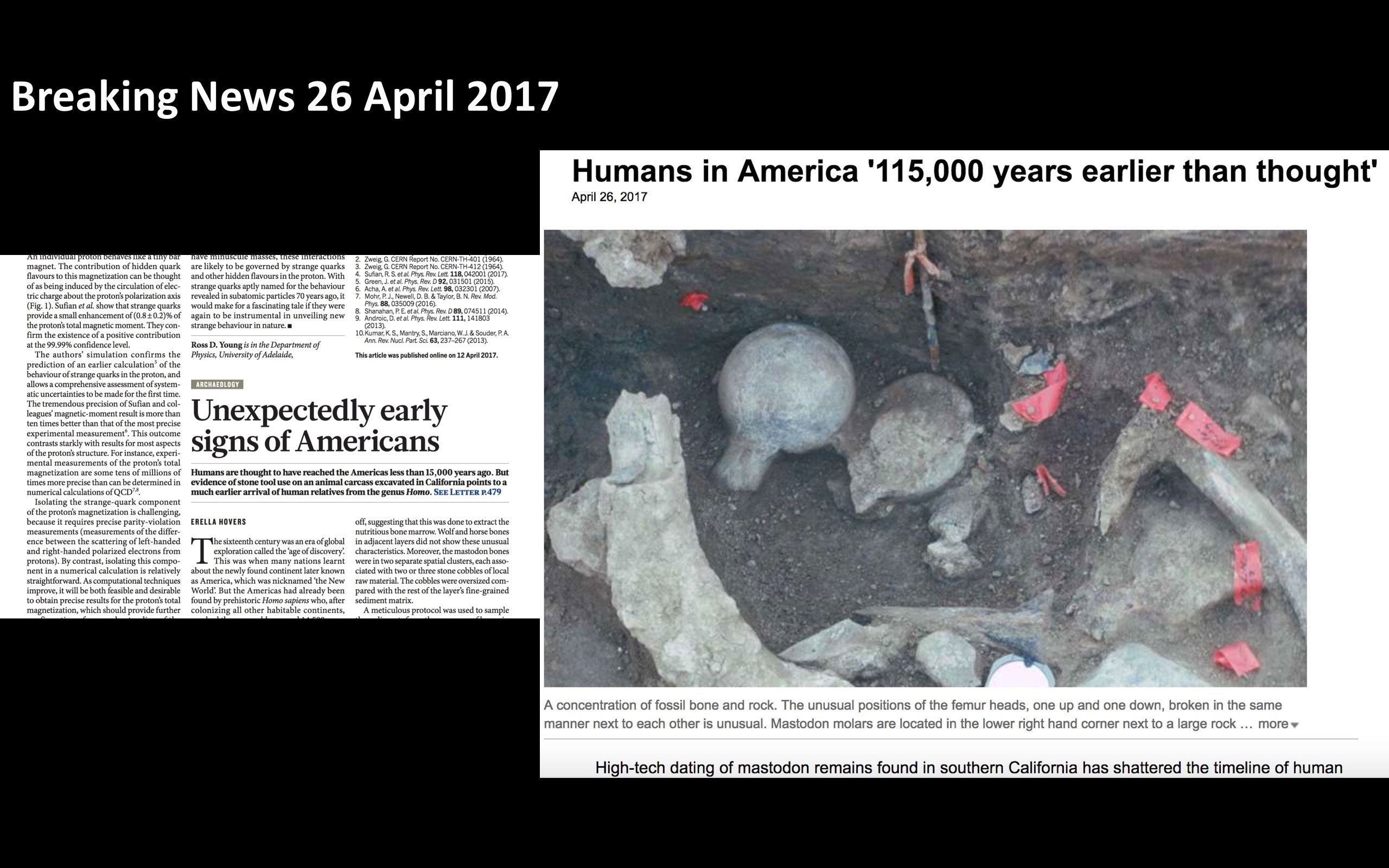
"raises serious questions about the effect of the bitter decades-long debate over the peopling of the New World. Did archaeologists in the mainstream marginalize dissenting voices on this key issue? And if so, what was the impact on North American archaeology? Did the intense criticism of pre-Clovis sites produce a chilling effect, stifling new ideas and hobbling the search for early sites? Tom Dillehay, an archaeologist at Vanderbilt University in Tennessee and the principal investigator at the Chilean site of Monte Verde, thinks the answer is clear. The scientific atmosphere, recalls Dillehay, was 'clearly toxic and clearly impeded science.'"138Even so hallowed a journal as Nature concurs in an Editorial which notes:
"The debate over the first Americans has been one of the most acrimonious — and unfruitful — in all of science... One researcher, new to the field after years of working on other contentious topics, told Nature that he had never before witnessed the level of aggression that swirled around the issue of who reached America first. 'When people stop listening to arguments and stop looking at data and instead just go with their own beliefs,' he said, 'that's when it becomes completely crazy.'"139Credit for the research breakthroughs that have entirely demolished the Clovis First model, Nature's Editorial continues:
"should go to openminded archaeologists, who were willing to investigate pre-Clovis sites seriously, and to geneticists, for bringing fresh ideas and techniques to bear on the topic. The recent finds and the shift in the debate have triggered a renaissance in ancient American archaeology. Researchers are reopening sites, reexamining specimens and searching for new sites to determine who the early pioneers were, and how and when they arrived.Meanwhile The Smithsonian approvingly cites Quentin Mackie, an archaeologist at the University of Victoria in British Columbia: "Clovis First will, I believe, go down as a classic example of a paradigm shift, in which the evidence for the collapse of an old model is present for many years before it actually collapses, producing a sort of zombie model that won't die."141
"As these ancient events are explored, some archaeologists should examine their recent behaviour. If what they lacked could be summed up in one word, it might be respect. Researchers must always consider that they might be wrong, and should look carefully at opposing data and conclusions. At the same time, scientists who make bold claims must marshal an extraordinary case, especially if they seek to topple a dominant model built on many previous studies. Such prescriptions sound obvious, but many scientists forget them, particularly in fields with limited data, such as archaeology."140
What's missing from all this, despite the calls for "respect" and for researchers to consider the possibility that they might be wrong, is recognition that the Younger Dryas impact hypothesis also has a bearing on the true history of the peopling of the Americas, and contains the seeds of an even more significant paradigm shift with even more profound implications for archaeology. Since they first proposed it in 2007, the team of scientists behind the hypothesis have certainly made "bold claims" but they have also marshalled "an extraordinary case" that, with the latest evidence of a widely-distributed platinum layer at the Younger Dryas Boundary, and intriguing support from Zamora's linked glacier ice impact hypothesis, does indeed have the potential to topple the dominant gradualist model built on many previous studies. That model, at least to my eyes, is beginning to look very much like a zombie that's presently being kept alive by Nicholas Pinter, Tyrone Daulton, Todd Surovell, Andrew Scott and others whose beliefs are radically contradicted by the notion of a sudden cataclysm over North America 12,800 years ago. And in just the same way that the toxic hostility of Clovis First proponents choked off funding for what Nature now recognises as "open-minded archaeologists" and held back promising new research for decades, so too the toxic hostility and premature "requiems" directed at the Younger Dryas impact hypothesis have choked off funding, held back promising new research, and failed to serve science.
It's high time for a change, indeed for a paradigm shift. When it comes I suspect it will reveal not only the true cause of the mysterious disappearance of the Clovis people but also vast and previously unexplored vistas of American prehistory. Archaeologists whose responsibility it is to explore that prehistory have been in the habit of regarding cosmic impacts, supposedly only occurring at multi-million year intervals, as largely irrelevant to the 200,000-year story of anatomically modern humans. When we believed that the last big impact had been the dinosaur-killing asteroid of 65 million years ago, there was obviously little point in trying to relate cosmic accidents on such an almost unimaginable scale in any way to the much shorter time-frame of "history". But the very real possibility emerging from the Comet Research Group's work that a huge, earth-shaking, extinction-level event occurred over North America just 12,800 years ago, in our historical backyard, changes everything.
So much more than Clovis was wiped away and obliterated during the Younger Dryas cataclysm that - who knows? - perhaps even the traces of a lost global civilisation will be uncovered there.
Atlantis?
The idea is not as far-fetched as it might seem, particularly when we remember that the Younger Dryas cataclysm was not a single event but an epoch with two pronounced nodes of disaster - the first, 12,800 years ago, accompanied by a humungous flood and abrupt, extreme global cooling, the second, 11,600 years ago, again accompanied by another humungous flood and this time by abrupt, extreme global warming.
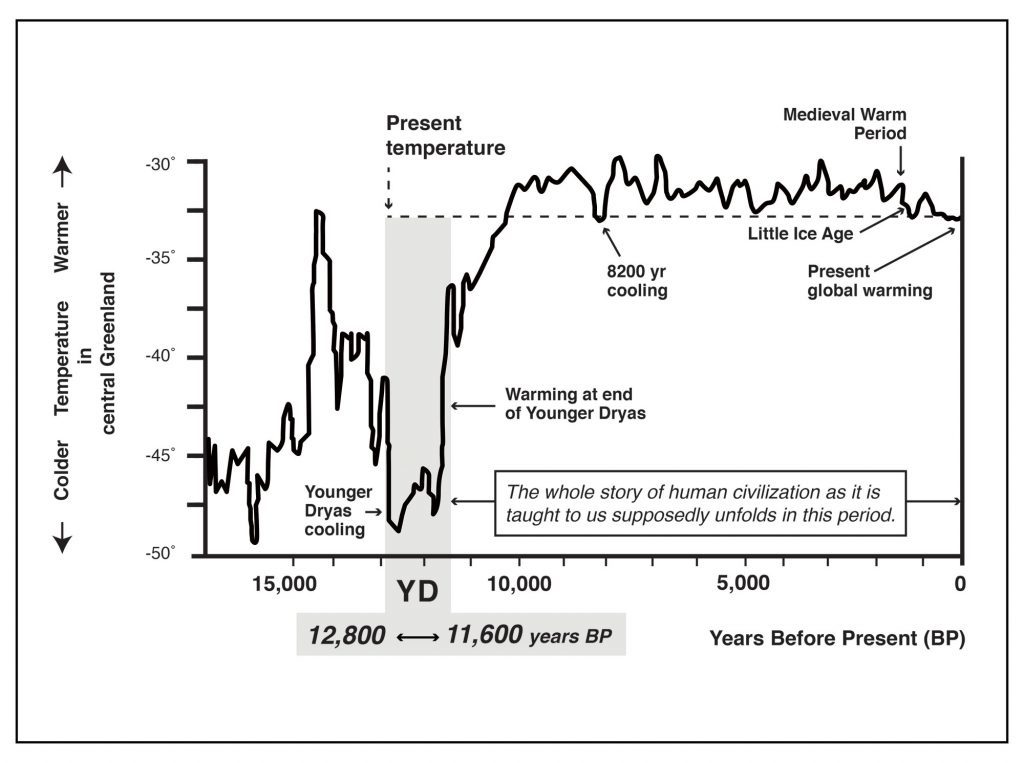
First, just as was the case 12,800 years ago, and as noted above, the date of 11,600 years ago coincides with an immense episode of global flooding - nominated by geologists as Meltwater Pulse 1B - as the remnant ice caps in North America and northern Europe collapsed simultaneously amidst worldwide global warming. The late Cesare Emiliani, Professor in the Department of Geological Sciences at the University of Miami, carried out isotopic analysis of deep-sea sediments142 that produced hard evidence of cataclysmic global flooding "between 12,000 and 11,000 years ago".143
Secondly, and rather strikingly, the Greek lawmaker Solon visited Egypt around the year 600 BC and there he was told a very remarkable story by the priests at the Temple of Sais in the Nile Delta - a story that was eventually handed down to his more famous descendant Plato, who in due course shared it with the world in his Dialogues of Timaeus and Critias.
It is, of course, the story of the great lost civilization of Atlantis swallowed up by flood and earthquake in a single terrible day and night nine thousand years before Solon's visit to Egypt144 — in other words in 9,600 BC, or 11,600 years before the present. Since that date (give or take a margin of error of a few decades) coincides with Meltwater Pulse 1B and is accepted by geologists as the "official" end of the last Ice Age145 - the end of the "Pleistocene" epoch and the beginning of our current epoch, the "Holocene" - it is intriguing, to say the least, that it coincides so precisely with the date that Plato gives us for the destruction, and submergence beneath the sea, of the lost civilization of Atlantis.
As I hope I have demonstrated in this article, historians and archaeologists will go through Houdini-like contortions of reason and common-sense rather than consider the possibility that any aspect of their paradigm of prehistory might be wrong — so I am not surprised that they have never attempted to investigate at face value the Atlantis tradition of a devastating global flood 11,600 years ago.
However, there are scholars — trained in other disciplines and not hobbled by the same preconceptions — who are more open to the possibility that the flood tradition in general, and the Atlantis story in particular, might be rooted in real events at the end of the last Ice Age. This view was, for example, entertained positively by Cesare Emiliani,146 whose work on global flooding at the end of the Ice Age was cited above. In the same vein, Robert Schoch, Professor in the Department of Geology at Boston University, notes the dramatic warming of the earth's climate that accompanied the flooding - ushering in the so-called "Pre-Boreal", the first stage of the Holocene - and observes that overall there is a:
"stunning line-up in time between the sudden warming of 9645 BC, Emiliani's scenario of a massive freshwater flood pouring into the Gulf of Mexico, and the date Plato ascribed to the sinking of Atlantis."147Likewise, science writer Paul La Violette argues that "there may be much truth to the many flood cataclysm stories that have been handed down to modern times in virtually every culture of the world. In particular, the 9600 BC date that Plato's Timaeus gives for the time of the deluge happens to fall at the beginning of the Preboreal at the time of the upsurge of meltwater discharge."148
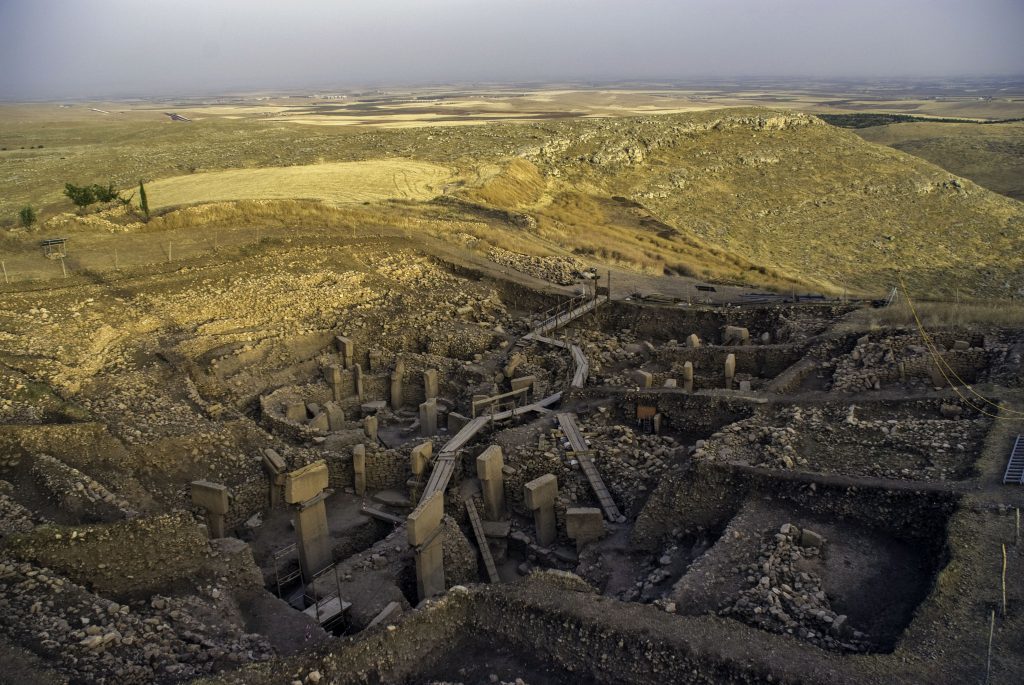
The beginning and the end
While the impact of comet fragments on the North American ice cap 12,800 years ago is now strongly supported by the mass of evidence reviewed in this article as the cause of the beginning of the Younger Dryas, there is much less clarity over what caused the end of the cold interval and the renewed flooding and warming of 11,600 years ago.
A particularly noteworthy aspect of this mystery, as we have seen, is that very radical climate changes occurred at both the onset and the termination of the Younger Dryas. In both cases these changes were global and were accomplished within the span of a human generation.150
Again the comet hypothesis helps to make sense of this. The estimated combined explosive force of the impacts would have lofted sufficient ejecta into the atmosphere 12,800 years ago to plunge the earth into a long, sustained twilight, akin to a nuclear winter - the "time of darkness" that so many ancient myths speak of - capable of reducing solar radiation for more than 1,000 years. The dramatic warming that began 11,600 years ago would then be explained by the final dissipation of the ejecta cloud coupled with an end to the system-wide inertia that had beset thermohaline circulation in the North Atlantic.151
Another possibility, not necessarily mutually contradictory with any of the above mechanisms, is that 11,600 years ago the earth interacted for a second time with the debris stream of the same fragmenting comet that had caused the beginning of the Younger Dryas 12,800 years ago. This is by no means implausible since the earth still passes through that debris stream twice a year. It is the well-known Taurid meteor stream, now 30 million kilometers wide. Travelling at around 2.5 million kilometers a day on its orbital path, our planet passes through the Taurid stream for around 12 days at the end of June and again for 12 days in late October and early November. At both transits, meteorites - "shooting stars" - in huge numbers enter and are usually small enough to burn up in our atmosphere (in October/November they are often referred to as the "Halloween Fireworks").
That sounds harmless enough but, as long ago as 1990, before any of the physical, geological evidence for the Younger Dryas comet impacts had been discovered, astrophysicist Victor Clube and astronomer Bill Napier warned of the view:
"that treats the cosmos as a harmless backdrop to human affairs, a view which Academe now often regards as its business to uphold and to which Church and State are only too glad to subscribe."152Such a view, in Clube and Napier's prescient 1990 opinion, is dangerous in that its effect is to "place the human species a little higher than the ostrich, awaiting the fate of the dinosaur."153
As can be seen from the reactions of some members of "Academe" to the Younger Dryas impact hypothesis, this view, and what Clube and Napier call the "great illusion of cosmic security"154 that it engenders, are still powerful forces in the world today. Much more than the truth about our own past is at stake, however, for there is a chilling convergence between Clube and Napier's findings on the one hand, and the findings of Kennett, West and Firestone on the other, as to what the Younger Dryas comet really means for humanity.
To understand the implications of this convergence properly it will be necessary to review some of the discoveries made by Clube, Napier and others in the 1980's and 1990's - discoveries, remember, that are completely independent of the later work of the Kennett/West/Firestone team on the Younger Dryas impacts. To cut a long story short, as I've already indicated, the burden of these discoveries is that it is possible - indeed highly probable - that we are not yet done with the comet that changed the face of the earth 12,800 years ago. Clube and Napier's work, with important contributions also from the late Sir Fred Hoyle, and from mathematician Emilio Spedicato and astronomer Professor Chandra Wickramsinghe, obliges us to consider the chilling possibility that the Younger Dryas comet was itself only a fragment of a much larger, giant comet - once perhaps as much as 100 kilometers in diameter - which entered the inner solar system about 30,000 years ago and was captured by the sun and flung into an earth-crossing orbit.
It remained relatively intact for the next 10,000 years. Then around 20,000 years ago it underwent a massive "fragmentation event" somewhere along its orbit that transformed it from a single deadly and potentially world-killing object into multiple objects grading down from 5 kilometers to 1 kilometer or less in diameter, each and every one of which would still, in its own right, be capable of causing a global cataclysm.155 The astronomers believe it was several fragments on this scale that hit the earth 12,800 years ago, causing the Younger Dryas,156 and that we can expect further encounters with the remaining fragments in the future.157 "This unique complex of debris," write Clube and Napier, "is undoubtedly the greatest collision hazard facing the Earth at the present time."158
The Taurid meteor stream, so called because its showers of "shooting stars" look to observers on the ground as though they originate in the constellation of Taurus, is the most familiar and best-known product of the ongoing fragmentation of the original giant comet.
"Shooting stars" are harmless - nothing more than tiny meteors burning up in the atmosphere - so why should we be in the least bit concerned about a meteor stream? In the case of the fifty or so distinct and separate meteor streams that have now been discovered by astronomers - the Leonids, the Perseids, the Andromedids, etc. - the answer to this question is that in most cases there is probably no danger and nothing to fear. Since most of the particles that they contain are indeed tiny, they represent no threat to the Earth.
But it is quite a different matter with the Taurid meteor stream. It too contains countless trillions of tiny dust-sized particles that produce nothing more dangerous than shooting stars when they enter the Earth's atmosphere. As Clube, Napier, Hoyle and Wickramsinghe have demonstrated, however, the Taurid stream also contains other much more massive material, sometimes visible, sometimes shrouded in clouds of dust, and all of it flying through space at tremendous velocities and intersecting the Earth's orbit twice a year, regular as clockwork, year in year out. Amongst these massive, deadly members of the Taurid family are Comet Encke, which is estimated to have a diameter of around five kilometers. But Comet Encke is not alone. According to Clube and Napier there are also:
"between one and two hundred asteroids of more than a kilometer diameter orbiting within the Taurid meteor stream. It seems clear that we are looking at the debris from the breakup of an extremely large object. The disintegration, or sequence of disintegrations, must have taken place within the last twenty or thirty thousand years, as otherwise the asteroids would have spread around the inner planetary system and be no longer recognisable as a stream."159In addition to Comet Encke, there are at least two other comets in the stream - Rudnicki, also thought to be about five kilometers in diameter, and a mysterious object named Oljiato, which has a diameter of about 1.5 kilometers.160 Initially believed to be an asteroid, this extremely dark, Earth-crossing projectile sometimes shows signs, visible in the telescope, of volatility and outgassing and most astronomers now regard it as an inert comet that is in the process of waking up.161 Comet Encke itself is known to have been inert for a long period, until it suddenly flared into life and was first seen by astronomers in 1876.162 It is now understood to alternate regularly, in extended cycles, between its inert and volatile states.
Clube and Napier's research had convinced them that an as yet undetected companion to Comet Encke is orbiting amidst clouds of harmless dust at the very heart of the Taurid meteor stream.163 They believe that this object is of exceptional size, that it is a comet, and that like Encke and Oljiato it sometimes - for very long periods - shuts itself down. This happens when pitch-like tars that seethes up continuously from its interior during episodes of outgassing become so copious that they coat the entire outer surface of the nucleus in a thick, hardening shell and seal it off completely - perhaps for millennia.164 On the outside all falls silent after the incandescent "coma" and tail have faded away and the seemingly inert object tears silently through space at a speed of tens of kilometers per second. But, at the center of the nucleus, activity continues, gradually building up pressure. Like an overheated boiler with no release valve, the comet eventually explodes from within, breaking up into fragments that can become individual comets every one of which threatens the Earth.
Calculations indicate that this presently invisible object at the heart of the Taurid stream might be as much as 30 kilometers in diameter.165 Moreover, it is thought likely that other large fragments accompany it. According to Professor Emilio Spedicato of the University of Bergamo:
"Tentative orbital parameters which could lead to its observation are estimated. It is predicted that in the near future (around the year 2030) the Earth will cross again that part of [the Taurid meteor stream] that contains the fragments, an encounter that in the past has dramatically affected mankind."166With this warning that an ancient enemy poses a real and present danger to the near and immediate future of civilization, let us return to the Younger Dryas and the possibility, after the first encounter 12,800 years ago, that the earth interacted for a second time with some large and dangerous comet fragments orbiting in the Taurid stream. On this hypothetical second occasion, however, the scenario proposed by the astronomers suggests that the primary impacts were not on land, or onto ice, but into the world's oceans throwing up vast plumes of water vapour and creating a "greenhouse effect" that caused global warming rather than global cooling.167
According to Sir Fred Hoyle:
"The difference between a warm ocean and a cold one amounts to a 10-year supply of sunlight. Thus, the warm conditions produced by a strong water vapour greenhouse must be maintained for at least a decade in order to produce the required transformation of the ocean, and this is just about the time for which water, suddenly thrown into the stratosphere, might be expected to persist there. The needed amount of water is so vast, 100 million million tons, that only one kind of causative event seems possible, the infall of a comet-sized object into a major ocean."168The Greenland ice cores, those invaluable windows into the past, tell us that 'temperatures rose in less than a decade at the climate transition marking the end of the Younger Dryas cold interval and the beginning of the warmer Holocene epoch 11,600 years before the present.'169 "In less than 20 years, the climate in the North Atlantic region turned into a milder and less stormy regime, as a consequence of a rapid retreat of sea-ice cover. A warming of 7 degrees Centigrade was completed in about 50 years."170
Professor Robert Schoch of Boston University prefers the date of 9700 BC - 11,700 years ago - for the sudden warming and flooding at the end of the Younger Dryas but agrees that this event was extremely abrupt. Indeed:
"given our inability to resolve the finest details of something that happened so long ago, it may literally have happened overnight..."171Schoch considers but does not accept Hoyle's proposal that this radical climate change was set in motion by a "comet-sized object" hitting a major ocean and instead has advocated the view that unusual solar activity was to blame:
"In the past, much more powerful plasma events sometimes took place, due to solar outbursts and coronal mass ejections (CME's) from the Sun, or possibly emissions from other celestial objects. Powerful plasma phenomena... hitting the surface of Earth could heat and fuse rock, incinerate flammable materials, melt ice caps, vaporize shallow bodies of water, creating an extended deluge of rain, and send the climate into a warming spell. The release of pressure that follows the melting of thousands-of-meters-thick ice sheets can induce earthquakes and even cause hot rock under pressure to melt and erupt to the surface as volcanoes...Schoch makes an interesting contribution to the debate with this notion, and he might ultimately be vindicated in his proposal that it was "solar outbursts and accompanying catastrophic cataclysms" that caused the abrupt ending of the Younger Dryas around 11,600 or 11,700 years ago.173
"The plasma event of 9700 BC eradicated advanced civilizations and high cultures of the time... This could be the basis for the nearly universal myth of a Golden Age... The 9700 BC event may be the original basis for the Atlantis legends; the timeframe fits well with Plato's account."172
On the other hand it is also perfectly possible that Hoyle will be vindicated and that comet impacts are implicated not only at the beginning but also at the end of the cold episode.174
More research certainly needs to be done to establish the exact mechanisms, in all their complexity, that brought about the sudden termination of the Younger Dryas, but the effects on global climate are already well understood. Just as much as the events of 12,800 years ago, the events of 11,600 years ago were, as J Harlen Bretz might have put it, "a debacle".
Could it be that those events, with North America standing squarely at their epicenter, were indeed the final straw that destroyed a great advanced civilization of prehistoric antiquity?
As we've seen, all the old archaeological certainties regarding the peopling of the Americas have now been thrown out with the recognition that Clovis was very far from being "first". Perhaps the lost civilization that I have spent the last quarter of a century trying to track down had its most significant outpost, possibly even its heartland, in North America in the period BEFORE the Younger Dryas cataclysms of 12,800 to 11,600 years ago?
That, however is another story.
Indeed, it is the subject of my next book.
See original for references.
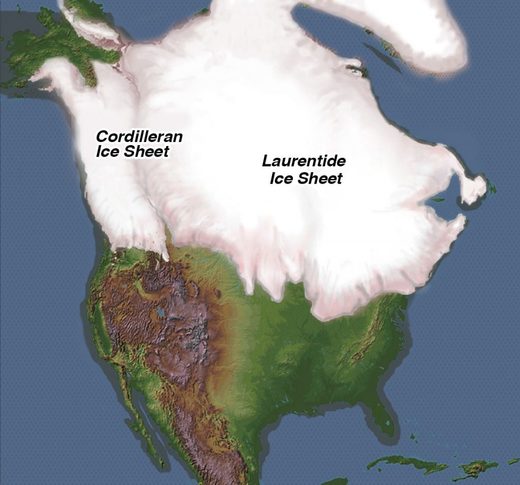
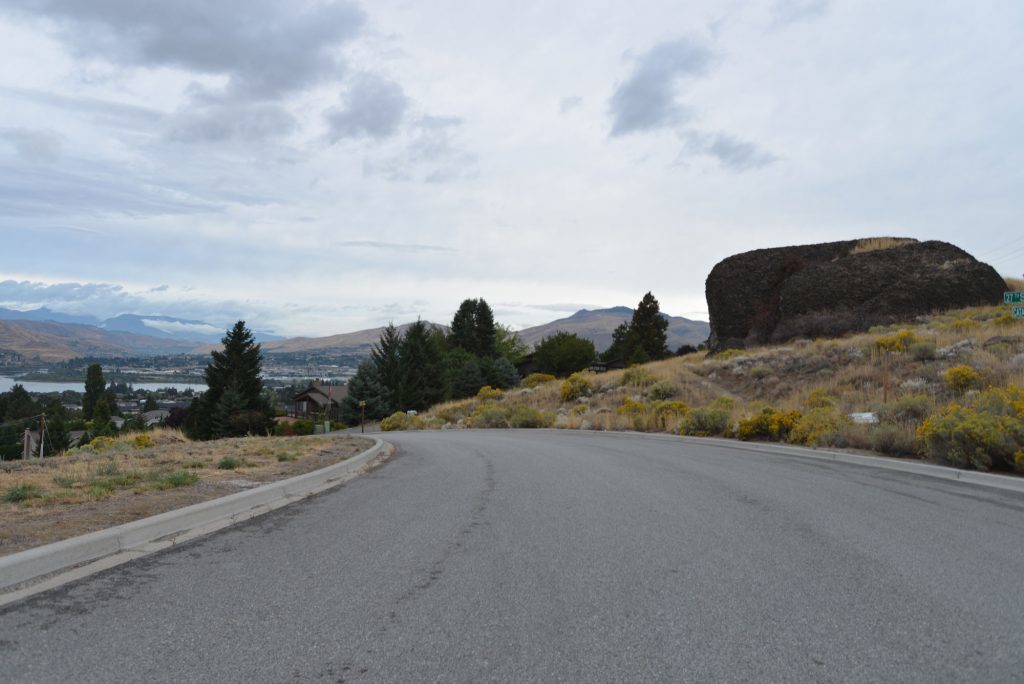
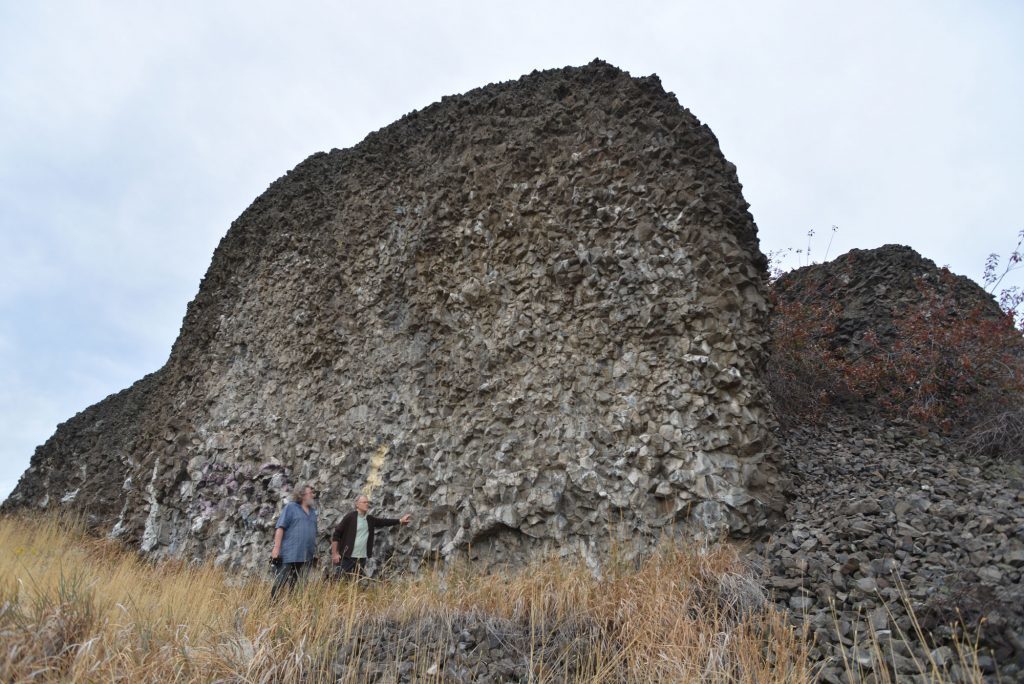
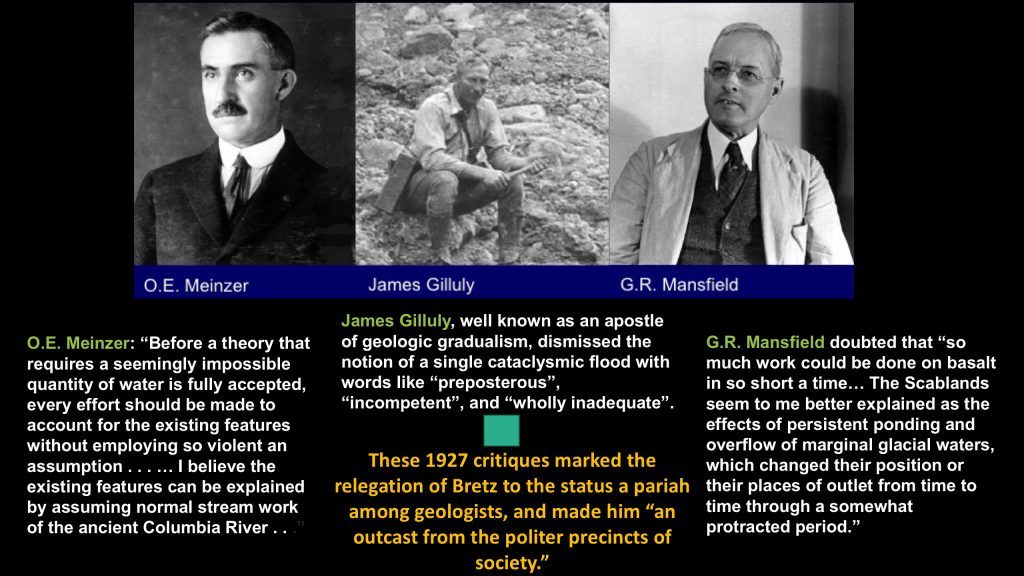
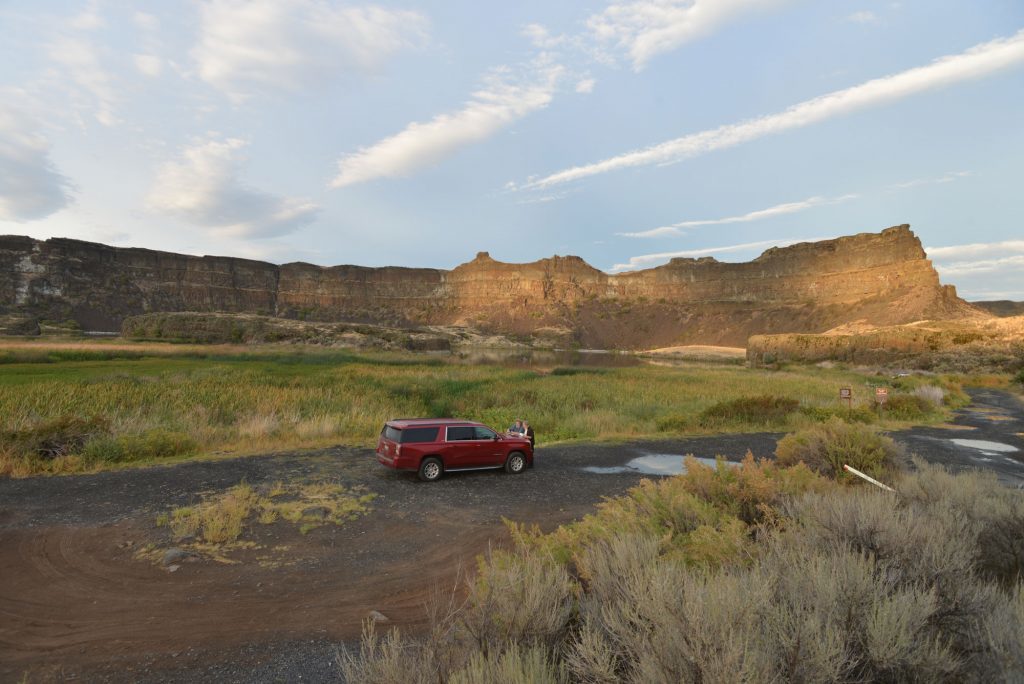
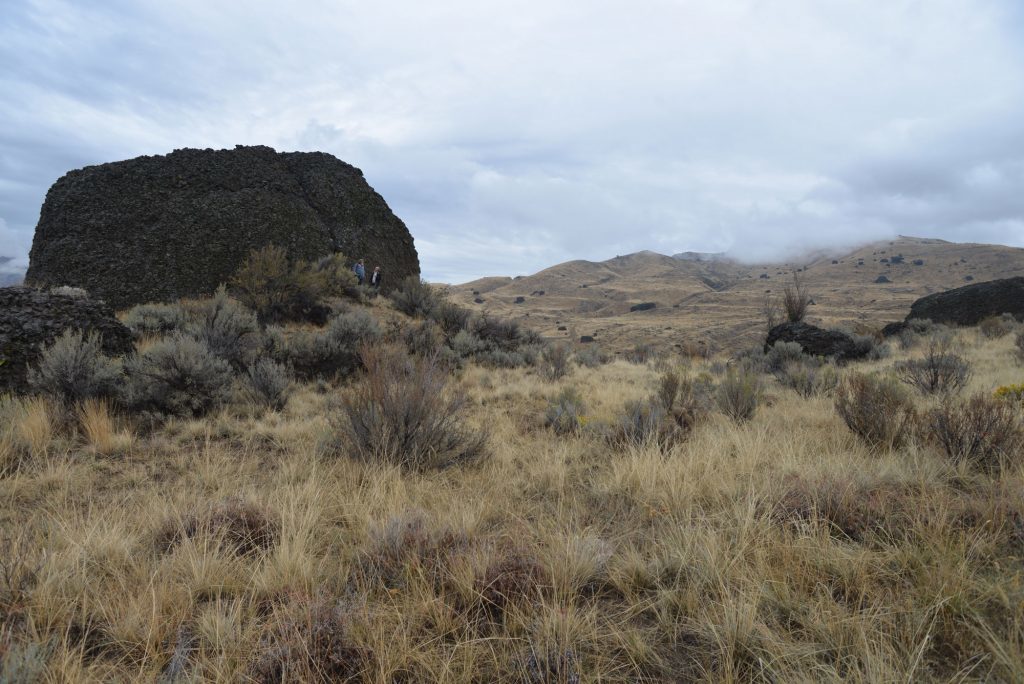
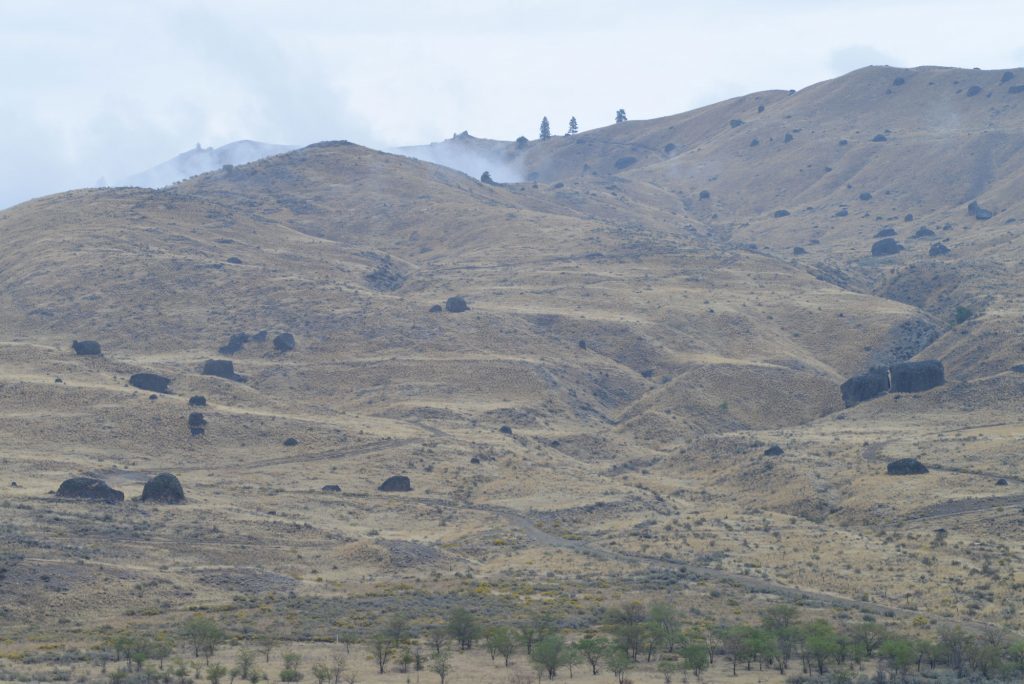
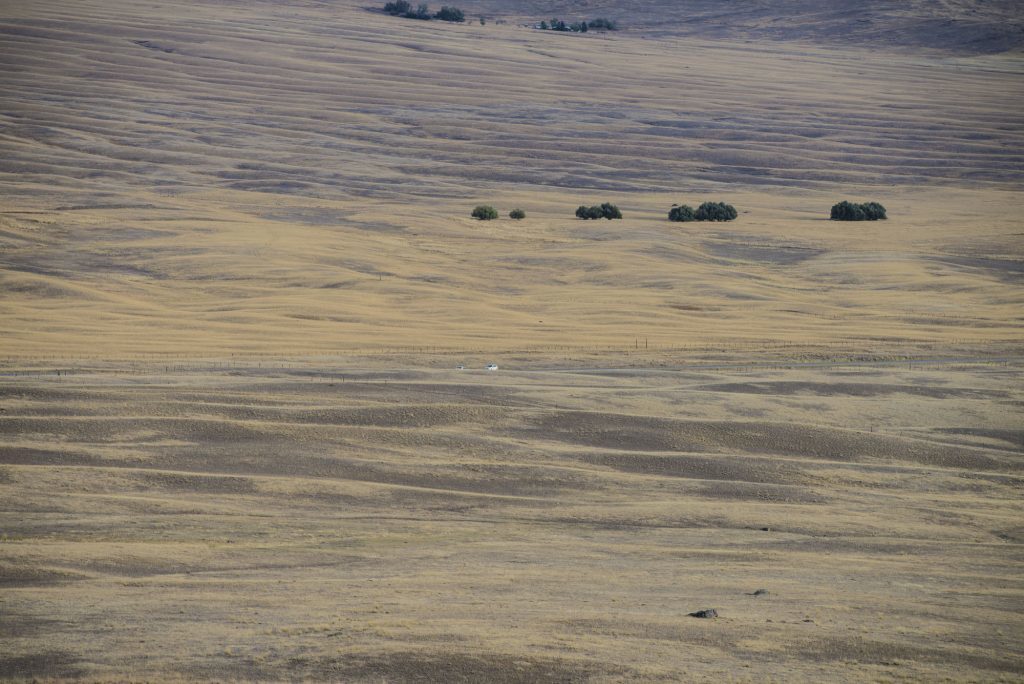
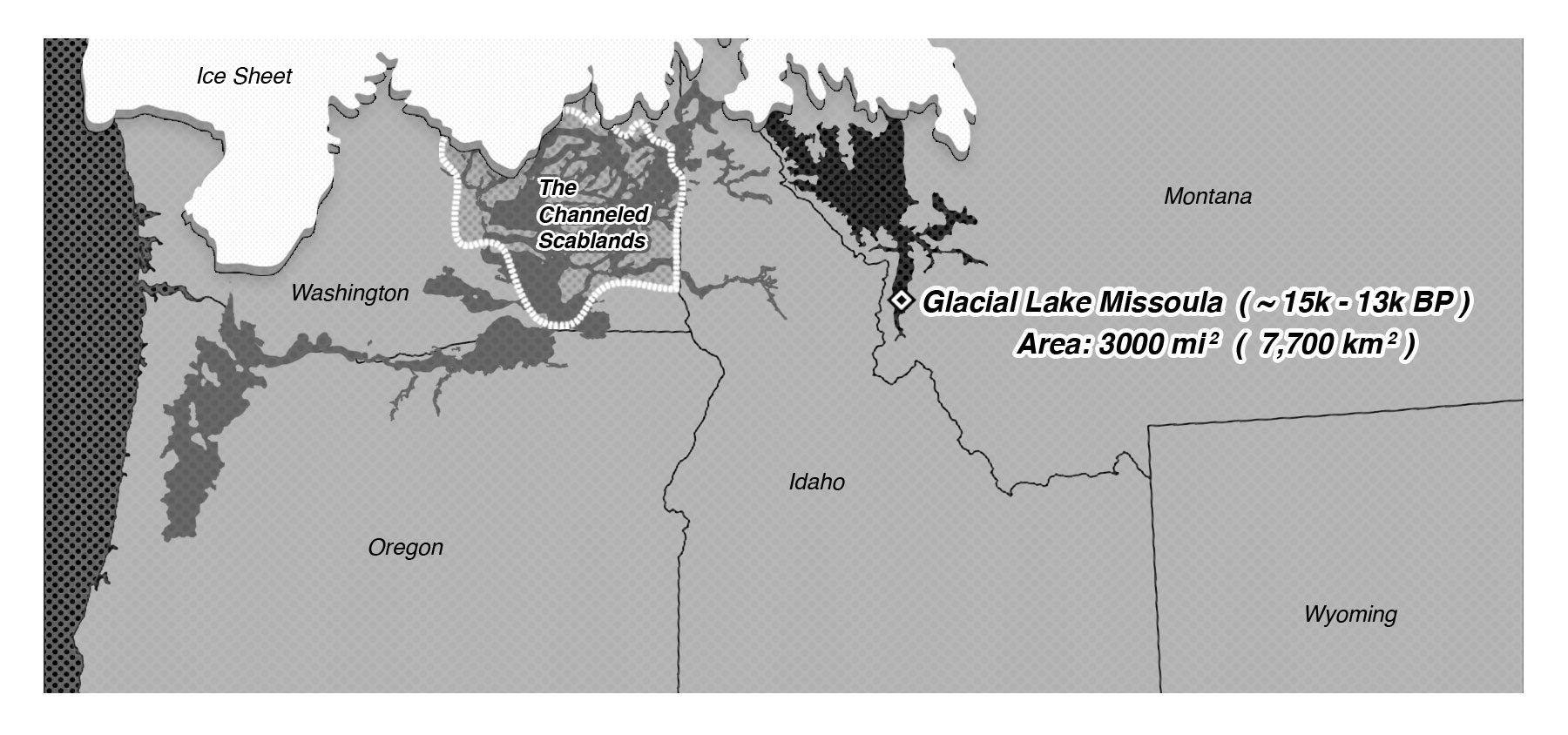

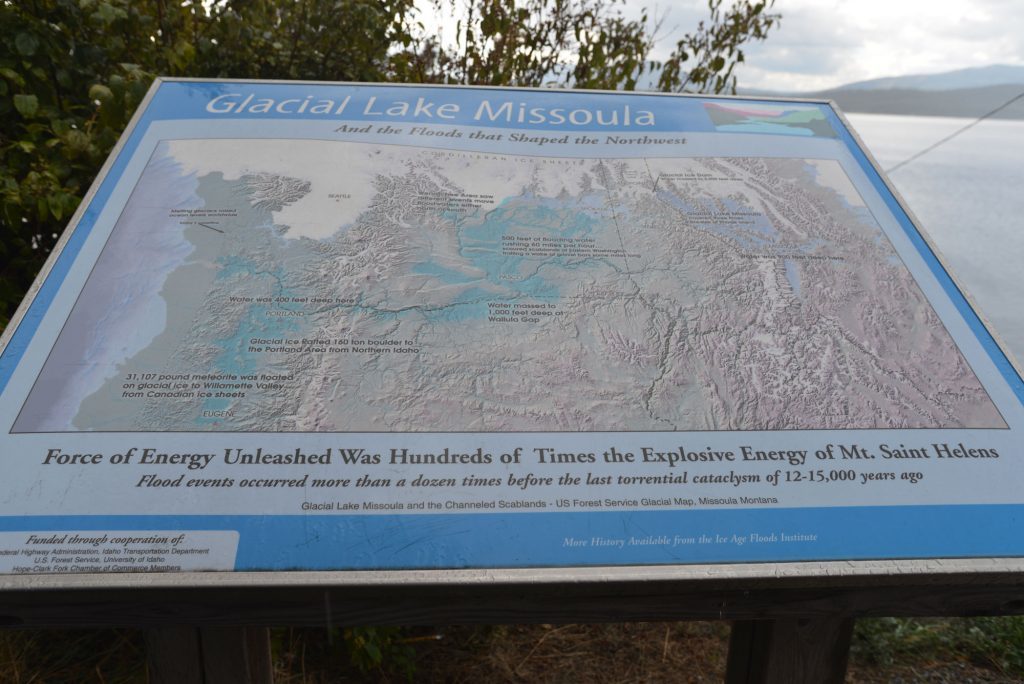
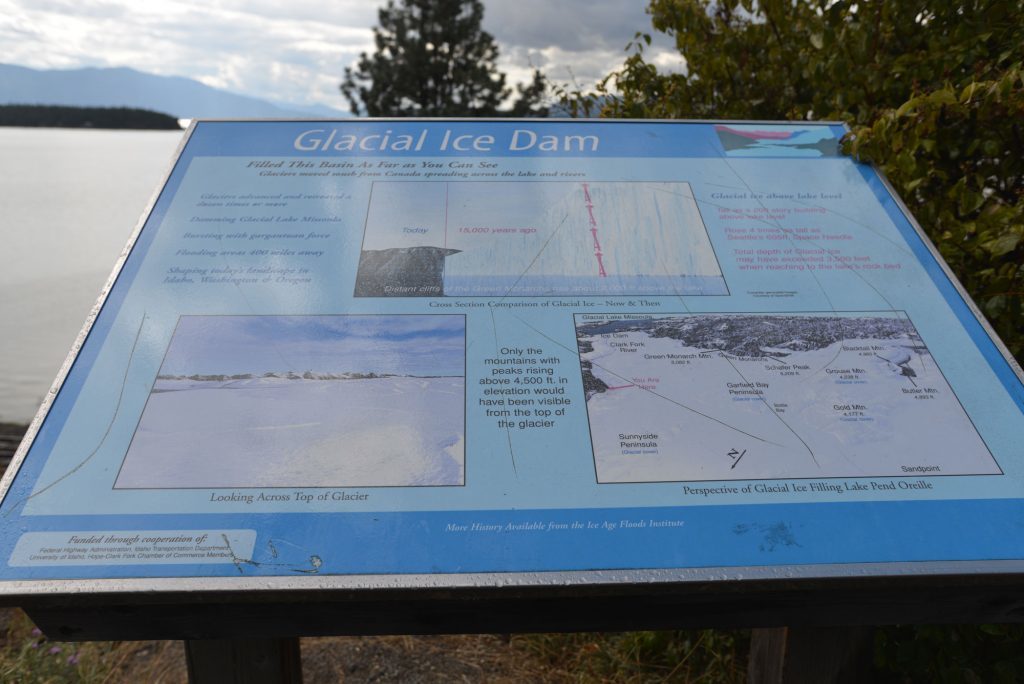

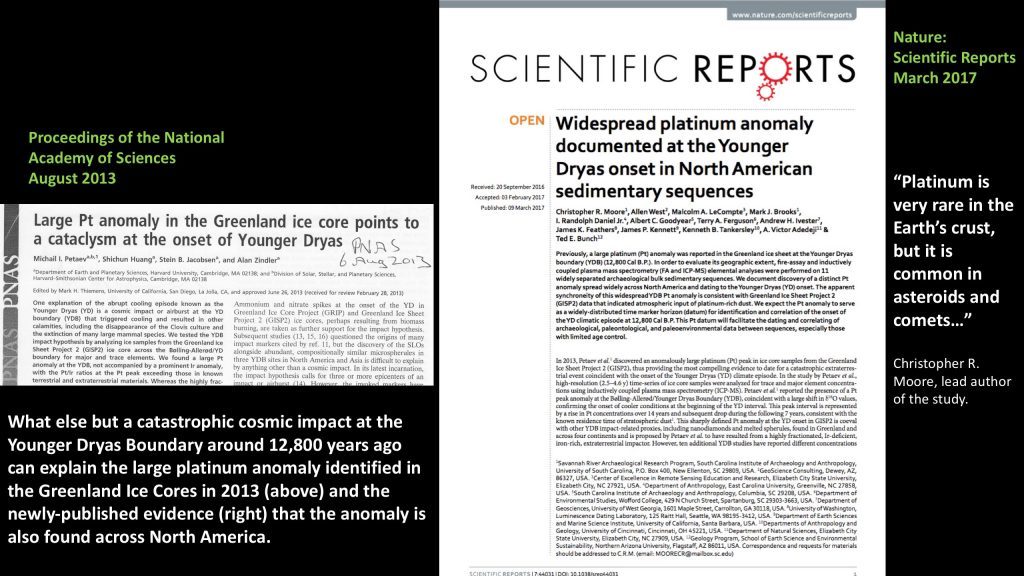
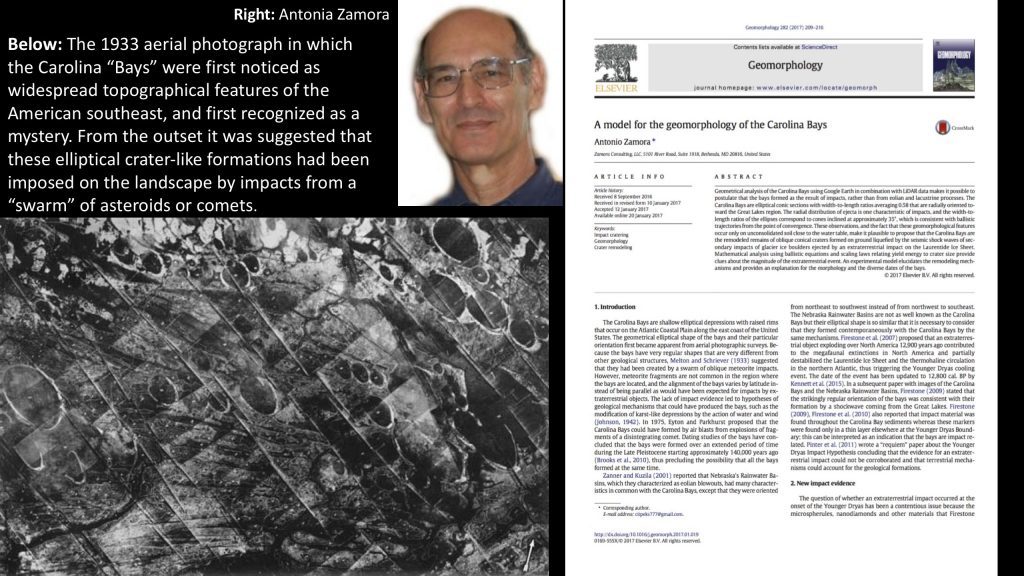
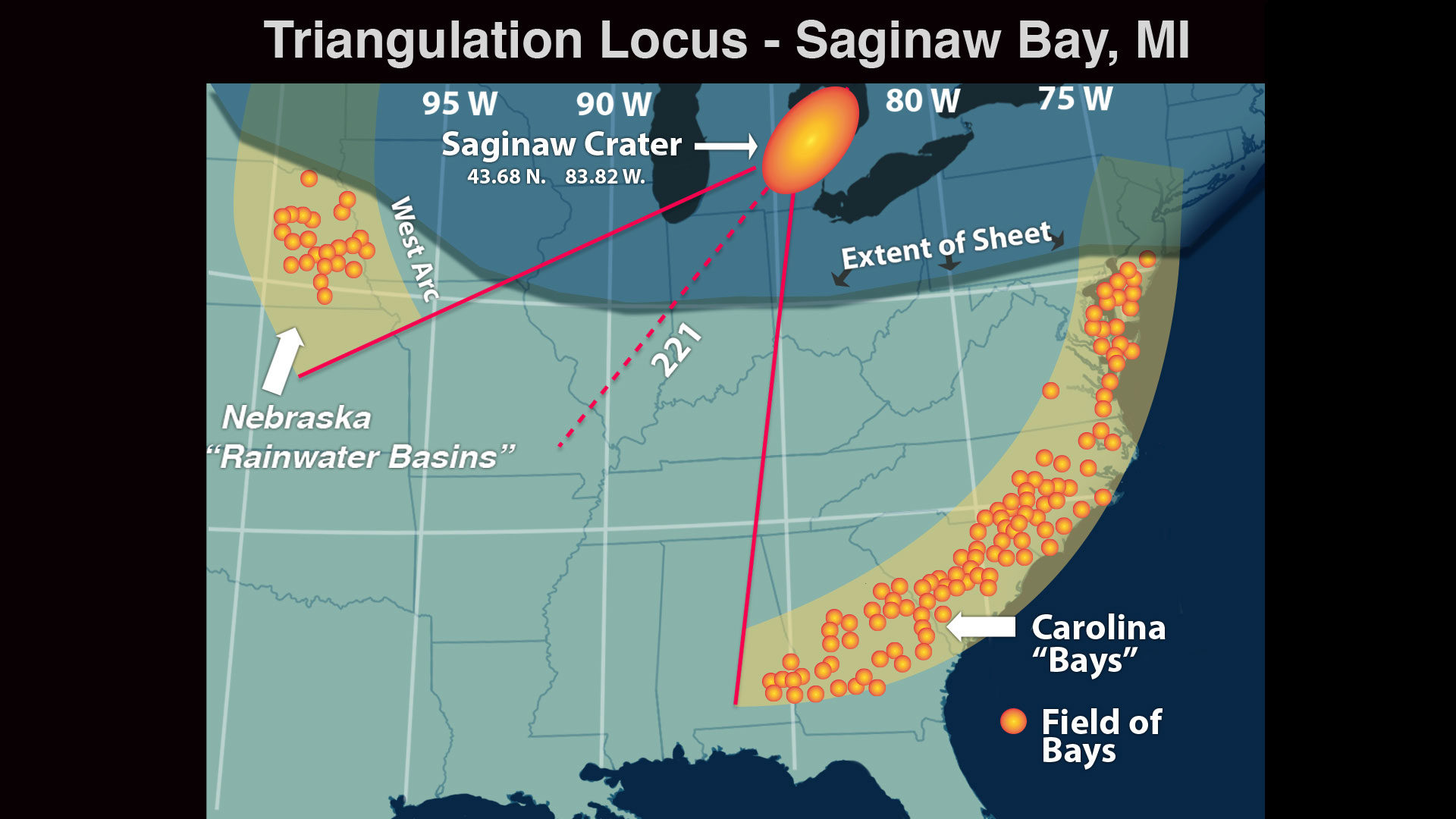
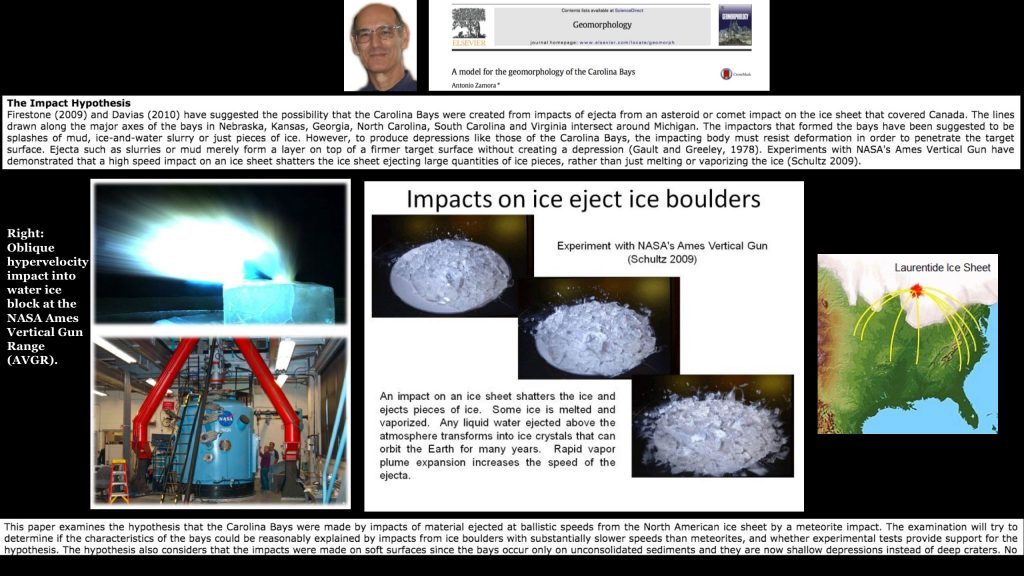
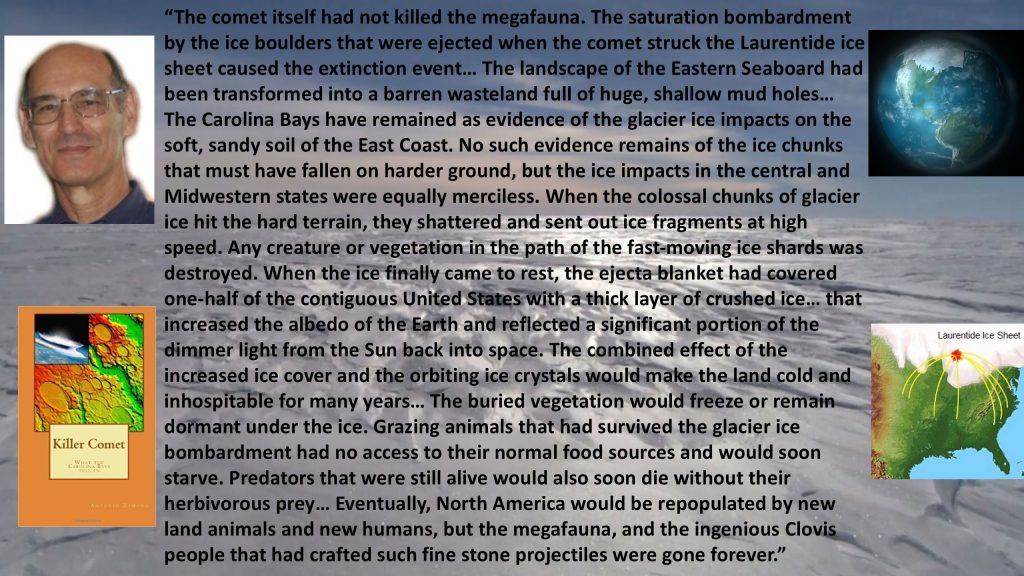
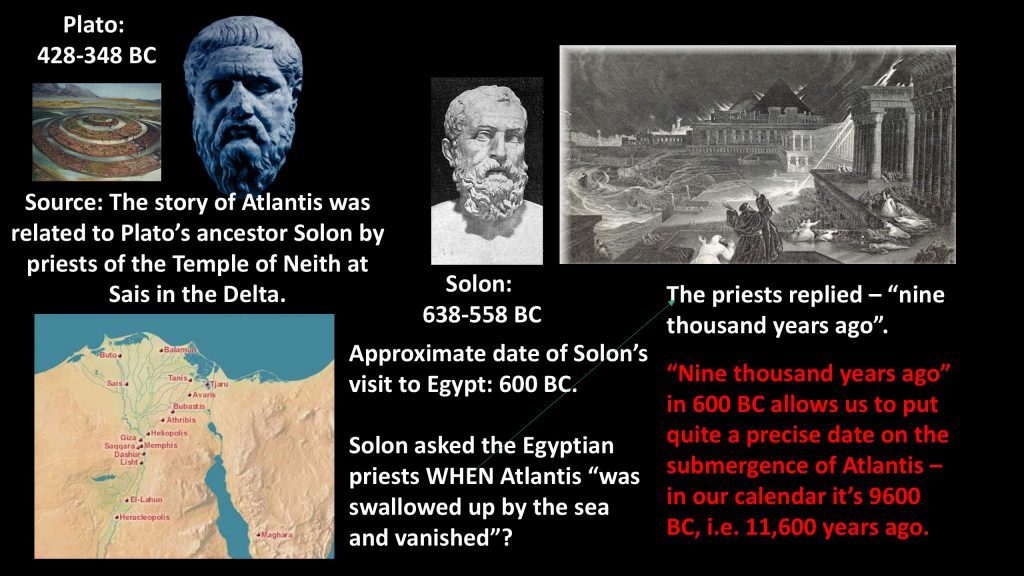



It seems to me that the 'colored orbs' and 'double suns' and the most recent orb with two craters are magnetic refractions of solar system bodies. Saturn producing the 'colored orbs' and the orb being Ceres. The question is how they are being displayed in our skies.
Unless the higher energy alone provided by the gas cloud we have entered is sufficient to bring the images of the solar bodies up close via an alignment, then we might consider that the photographic stream sent from the satellites --Cassini from Saturn and Ceres Dawn both from NASA--has been subject to magnetic refraction capture and subsequent display in our skies.
Just musing but this high energy magnetic capture could explain the knowledge of our planetary system and even more distant by our smarter us--the Ancients.